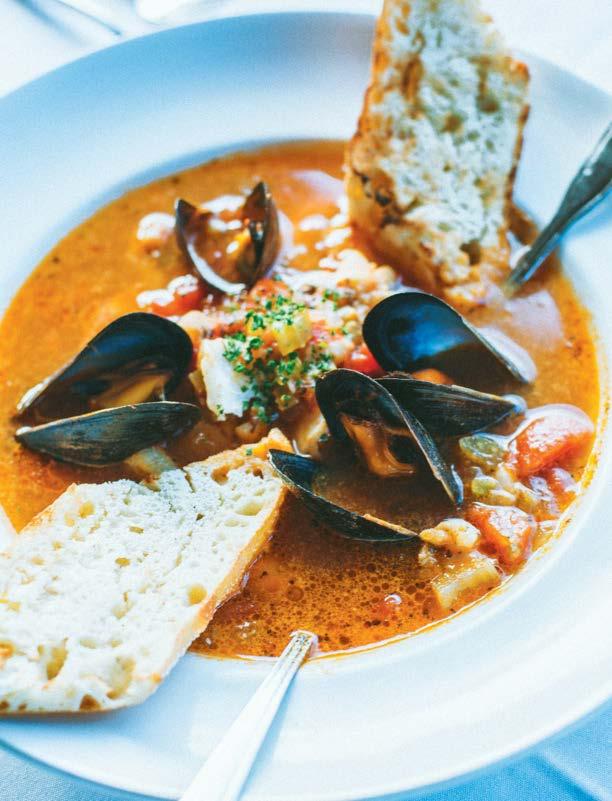

® Pig Roast • La Posta • Kombucha, Kvess and Kefir Local Catch • The Cult of the Dry-Farmed Tomato Café Culture • I’ll have a beer with that Local Food on Foot Celebrating the Local Food and Wine of Santa Cruz, Monterey and San Benito Counties Fall 2012 • Volume 2 • Number 1
edible monterey bay
Member of Edible Communities

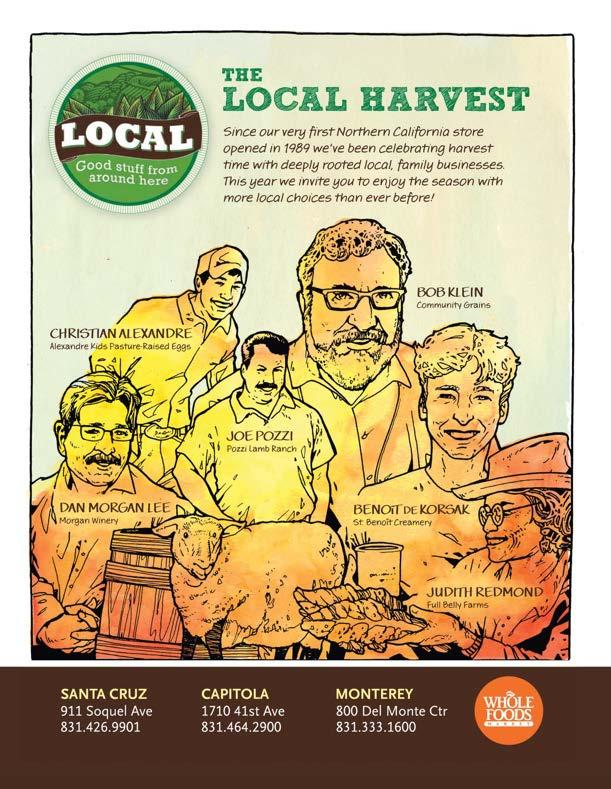
4 Grist for the Mill
7Edible Notables
Local Food on Foot • Café Culture • Grow your own What’s in your food?
14What’s in Season The cult of the dry-farmed tomato
The story behind a deceivingly modest-looking fruit and its irresistible flavor
19Edible Schoolyard Teachable Moment Reaching at-risk youth through food
23Out to sea Catch This!
Local Catch connects us to our bay—and attracts an ardent following
32Back of the House For the Love of Italy La Posta restaurant and the globetrotting women behind it
39Liquid Assets I’ll have a beer with that Local chefs ditch the wine to create beer-centered dinners
46Foodshed Pig Roast
A chef experiences where his pork comes from
53Roadside Diaries Love Story
How one determined woman restored the historic Mesa Del Sol ranch, started a boutique winery and built a sustainable retreat center to honor her late husband
59The Preservationist Kombucha, Kvess and Kefir Fermenting delicious drinks at home
62Edible events Costanoa Lodge, Earthbound Farm and the Restaurant at Ventana Food adventures in Big Sur, Pescadero and Carmel Valley
69Fall Farmers’ Markets
71Dine Local Guide
77Map of the Region/Local Source Guide
80Local Libations 3 of a Kind Soft drinks reimagined by a mom
Cover Photograph: Cioppino at Cascade Bar & Grill by Ted Holladay
Contents Photograph: Salmon fishing by Alan Lovewell
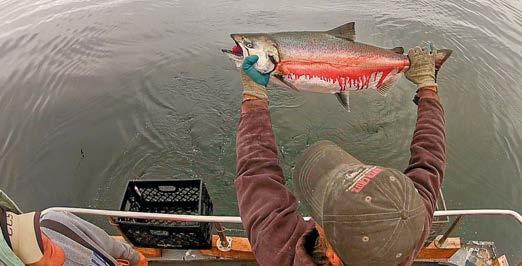
2 edible monterey bayfall 2012
Contents
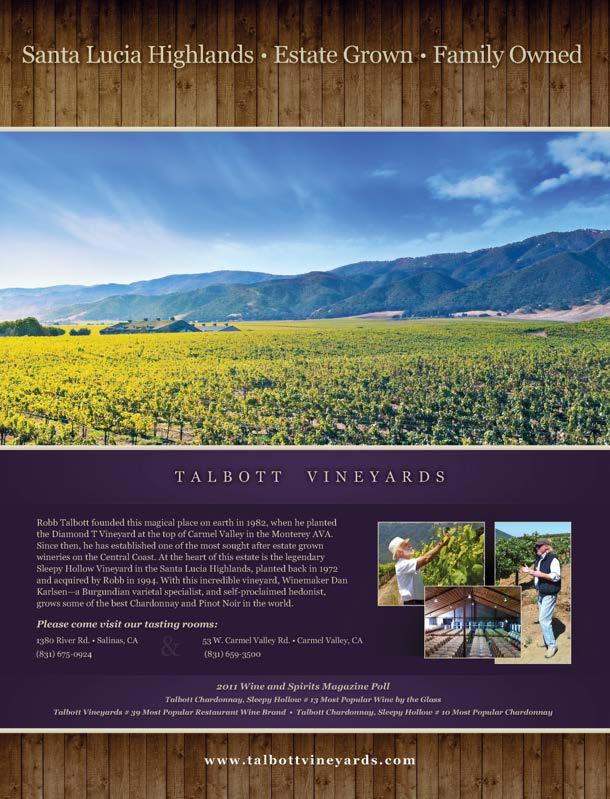
GRIST FOR THE MILL edible monterey
bay
PUBLISHER AND EDITOR
Sarah Wood
Sarah@ediblemontereybay.com 831.238.1217
CO-PUBLISHER AND ASSOCIATE EDITOR Rob Fisher
COPY EDITOR Doresa Banning
You would think that Americans spend more on food today than they did 30 or 50 years ago. After all, food prices always seem to be on the rise, and more and more people are striving to feed their families high quality, healthy food.
Think again.
Americans on average spent just 15.3% of income in 2011 on food—less than half of the 40% of income spent on food in 1949, according to NPR Planet Money’s Graphing America series.
Why? One reason is that many categories of food have actually plunged in price, and Americans have been choosing to eat the cheap stuff.
Some would say we’re not even eating food at all: Processed foods and sweets make up a whopping 22.9% of the average American food budget, according to the Graphing America series. That’s more than we spend on any other category of food—and almost exactly double the amount we spent on processed foods and sweets 30 years ago. Knowing this, it’s not very surprising that obesity and diabetes are reaching epidemic proportions.
Meat, our previously No. 1 food expense, dropped by a third to 21.5% of total food expenses. That’s not necessarily because Americans eat less meat, but because factory farming has driven down prices (pork chops have fallen 37.9%, for example). Meanwhile, the dropping prices take a toll on smaller, more humane and environmentally conscious ranchers whose products are better for us.
Statistics aside, if we as a society valued the food we eat more, farmers and farm workers would be able to make a better living, the land would be treated better, and less food would be wasted every day. If everyone bought organic and sustainably produced food, their costs would go down and they’d be available to more of us. Additionally, if we put a higher value on our food, we would also savor and enjoy it more, appreciating the flavors, the stories, and the communities that good food tends to bring into our lives.
We hope that this issue of Edible Monterey Bay—and each issue, in fact—offers you much inspiration to further the movement taking place all around us to value our food more—and likewise to support the local farmers, fishermen and food artisans who make healthy eating possible.
This issue also marks Edible Monterey Bay’s first anniversary, and we’d especially like to express our profound thanks to our forward-thinking advertisers, our talented contributors and staff, our subscribers, our colleagues within the Edible Communities network and many others who helped us hit the ground running just one year ago.
We wish you a happy and healthy autumn—and hope you’ll enjoy the fall harvest!
Wood and Rob Fisher Publishers
DESIGNER Melissa Petersen WEB DESIGNER Mary Ogle
CONTRIBUTORS
Jordan Champagne • Jamie Collins
John Cox • Philip Geiger
Elaine Hesser • Margaux Gibbons
Ted Holladay • Elizabeth Limbach

Geneva Liimatta • Alan Lovewell
Deborah Luhrman • Camilla M. Mann
Anina Marcus • Ray Patterson Pete Rerig • Patrick Tregenza Lisa Crawford Watson
ADVERTISING SALES
Shelby Lambert • 831.238.7101
Shelby@ediblemontereybay.com Kate Robbins • 831.588.4577 Kate@ediblemontereybay.com
DESIGN AND ELECTRONIC MEDIA ASSOCIATE Katie Reeves
DISTRIBUTION
Rachel Hauptman • Angie Lee
CONTACT US:
Edible Monterey Bay 24C Virginia Way, Carmel Valley, CA 93924 www.ediblemontereybay.com 831.238.1217 info@ediblemontereybay.com
Edible Monterey Bay is published quarterly. All rights reserved. No part of this publication may be used without written permission of the publisher. Subscriptions are $28 per year at www.ediblemontereybay.com. Every effort is made to avoid errors, misspellings and omissions. If, however, an error comes to your attention, please accept our apologies and notify us. Thank you.
4 edible monterey bayfall 2012
Sarah
Photo by Zoe Fisher


Edible Notables Local Food on Foot
Two unexpectedly intriguing and delicious adventures
Some people are tour people, relying on a resident expert to guide them from one location to the next while pointing out spots of interest along the way. I’ve never been a tour person. In fact, it wouldn’t be hyperbolic to characterize myself as tour averse. When travelling, I typically rent a house with a kitchen, frequent neighborhood grocers, seek out farmers’ markets, stop at roadside fruit stands, cook with local produce and steer clear of anything that could possibly be called a tour. But then I tried a food tour.
Three weeks ago, I didn’t know what a food tour was. Now, I’ve been on two of the three food tours offered in the Monterey Bay region: the Santa Cruz Food Tour, run by Brion Sprinsock and Kristine Albrecht, and the Carmel Food Tour, led by Staci Giovino. Now, I have to admit it: I’m smitten. Food tours offer a culinary and cultural adventure, opening up locals and visitors alike to exceptional eateries and introducing them to new artisanal foodsmiths.
I stumbled across the Santa Cruz Food Tour while searching for a unique outing for my family. Walking, eating, drinking. Three of our favorites. I expected an almost two-mile walk and insider information about the stops we were making. I didn’t expect lessons in California history and Victorian architecture and—even after living in this area for almost three decades—to discover new culinary gems that had escaped my food radar. It was the same with the Carmel Food Tour that I took a couple of weeks later. We followed our guide through geranium-scented passageways that I had never seen, much less explored. Collectively, my friend and I have lived in the area for 40 years; still, at almost every stop, our whispers began with “Wow, I’ve never...”
Sprinsock started the Santa Cruz Food Tour—and his new Capitola Food Tour—because the tours dovetail his interest in local history and architecture with his desire to shine the spotlight on locals who serve up something exceptional. Giovino fell into culinary tourism via interior design. She shared that her career in designing commercial spaces was about creating an experience. Food tours are much the same. Both Sprinsock and Giovino’s passions and knowledge come through in their tours. Though the tours were very different, each captured the personality of its city in a new way.
The almost seven hours I spent on the food tours—three and a half hours in Santa Cruz and three hours in Carmel—taught me local history that I’d never known: why the Mission Hill tunnel, a 900-foot long, narrow-gauge railroad tunnel, was built by immigrants from Cornwall versus the Chinese laborers who laid a majority of the lines in California; how Sebastian Vizcaino discovered Monterey Bay; how the dairy industry shaped downtown Carmel; and how a milk shrine worked. But rather than be a spoiler, I’ll just give you a few tasty tidbits. Here’s my journey to food-tour junkie through a series of “I’ve never...”

...eaten peppercorn ice cream. The Penny Ice Creamery makes small batches of ice cream completely from scratch, in-house every day. Their flavors change with the seasons, featuring locally farmed and organic ingredients. I love that they utilize a professional forager. As seasons shift, they create ice creams with what can be readily found on a day hike. We missed their candy cap mushroom by a month. Next year!

www.ediblemontereybay.com 7
Story and photos by Camilla M. Mann
The Penny Ice Creamery.
Shooting olive oil.
...known that “cheddar” can be a verb. To cheddar. Cheddaring is the process of cutting, stacking and expressing the whey from curds to temper them into a denser, more cohesive mass. Kent Torrey, of The Cheese Shop, has a motto I can get behind: “Eat cheese. Drink wine. Live life happy!” We ate cheeses from three continents, sampling a Cheddar from the English village of Cheddar; an Argentinian Reggianito, a granular cow’s milk cheese from Italian immigrants who wished to make a cheese reminiscent of their native Parmigiano; and a handcrafted, raw milk Swiss, named “Junipero” for Father Serra, out of our local family-run Schoch Dairy in Salinas. The Schochs also make an East of Edam in homage to Salinas-born author John Steinbeck.
...shot olive oil. To really taste the oils, Sprinsock explained—and demonstrated—you should shoot the oil to the back of your throat. Like a shot. It was a proud moment for me to watch my 8- and 10-yearold foodies-in-training throwing back shots of olive oils, sipping vinegars and commenting on what they tasted and how they would use them. At both the True Olive Connection, in Santa Cruz, and the Bountiful Basket, in Carmel, we tried a variety of olive oils and balsamic vinegars. The oils ranged from light and buttery to leafy and peppery and everything in between; the vinegars ran from a traditional, 18-year-old balsamic to 6-year-old, flavored balsamics such as pomegranate, ripe peach, dark chocolate, espresso and blueberry.
...known how salumi—Italian-style cured meat products— are made. Salumi has at its root “sal,” Latin for salt, and is predominantly made from pork. While we sipped a big Tuscan red, Grant
Dobbie, Salumeria Luca’s manager, explained the process of making salami and mortadella: grind the meat, season and salt, then stuff into a casing. From there, you might bake it or steam under pressure. I learned the difference between speck, which comes specifically from the Alto Adige region in Italy, and prosciutto. While both speck and prosciutto are salt-cured hind-quarters of the pig, only speck is smoked.
On both tours, the groups were small and intimate. Ages varied, from elementary schoolchildren to retirees, and we hailed from all over the country, ranging from local communities to more than 3,000 miles away. The common thread: we were ready for an offthe-beaten-path adventure punctuated with delicious foods and interesting libations. So if that’s what you’re after, you just might be a food-tour person. I discovered that I am.
Santa Cruz Food Tour: 800.838.3006, www.santacruzfoodtour.com
Carmel Food Tour: 800.979.3370, www.carmelfoodtour.com

8 edible monterey bayfall 2012
Edible Notables Café Culture
Vertigo Coffee’s Dmitri Fridman resets the table in San Juan Bautista
 By Lisa Crawford Watson
By Lisa Crawford Watson
Dmitri Fridman speaks softly and slowly, a hint of his Russian heritage inflecting his words. Nearby, coffee slips down the sculptural blown-glass spiral of a Kyoto slow dripper, one drop at a time, yielding a dark, smooth cup of coffee. Fridman is sipping a glass of his cold-brewed iced coffee and having one of his signature multigrain pizzas, baked in a new wood-fired pizza oven and topped with paper-thin slices of potato and Meyer lemon and dollops of caramelized onion and goat cheese.
Fridman is enjoying the patio of his own Vertigo Coffee, the San Juan Bautista coffee roaster he opened with his wife, Kitty Fridman, just two years ago. The spot has already become a beloved community gathering place for locals and tourists alike who value fresh, delicious food and, especially, a really good cup of coffee. But don’t call it a coffee shop.
“The difference between a coffee shop and a coffee roaster,” says Fridman, “is fresh coffee. It’s hard to believe that a lot of people have never had fresh coffee. They think they have because they have had freshly ground coffee. But they haven’t had fresh roasted. Coffee is quite perishable and is best within the first 10 days of roasting. So it is a curse for us roasters because it has a short shelf life. People compare fine coffee to fine wine, but it is not the same. Wine can improve while it sits on the shelf but not coffee.”
Next to drinking it, Fridman enjoys nothing better than discussing coffee with his customers and explaining the fine art of coffee roasting, brewing and sipping. People always have questions, he says, particularly about freshness. But that is only part of a good cup of coffee. It begins, he believes, with the quality of the bean.
“It starts with the farmers, among the most impoverished people in the process. They farm these steep slopes, harvesting the coffee cherries, knowing that each coffee tree produces just one to two pounds of coffee a year. Anytime I can buy my beans directly from the farmers, I do. This makes a huge difference between average and great coffee in the cup. If there is a little extra price by the time it gets to the cup, it’s worth it. And my customers agree.”
Evidence that Fridman has struck a chord in San Juan Bautista shows up in the neighbor who shares the Meyer lemons from his tree, the time that another neighbor devotes to tending the restaurant’s herb garden and the stream of customers Fridman recognizes by face, if not by name. On any day, you might see local winemakers, cattle ranchers and poultry farmers, as well as visitors who’ve happened in.
“I love the cold-brewed drip coffee. Because it has 70% less acidity, I am able to have coffee,” says Mary Morales, a long-time San Juan Bautista resident who, with her husband Rick Morales, has be-

www.ediblemontereybay.com 9
Photos by Philip Geiger
come a Vertigo regular. “But everything they sell here is fabulous. And the people here are wonderful—warm and friendly and welltrained. We come down and sit here on a Sunday, to just relax and feel like tourists. We needed something like this in town; we’re happy to see they’re getting the business.”
Fridman’s dream to open the roastery dates back to the 1980s, when he spent time in Italy while emigrating to the United States. In Italy, he tasted his first sip of cappuccino and it was a revelation. At first he thought he would try to recreate the experience; eventually he realized he just wanted to recreate that cup of coffee, and let the revelations come to his customers on their own.
He named the place Vertigo, not because the caffeine will make your head spin but in a nod to Alfred Hitchcock’s 1958 thriller of the same name, whose most notable scene was filmed in San Juan Bautista.
Located on Fourth Street, one block off the town’s main commercial street, Vertigo resides inside a large, angular white building that used to garage trucks for Culligan Water. Now, the place exudes both warmth and a bit of industrial chic. Simple, honey-colored wood tables and chairs sit atop textured cement floors. Once a shelter for trucks and water tanks, the room now houses a vintage German-made, cast-iron roaster Fridman found on craigslist, two Kyoto slow drippers, dark wooden counters and a glass case for pastries and other freshly made food.
The pastries are baked daily by the artisanal Provence Bakery located in Prunedale and in the Del Monte Shopping Center in Monterey. The pizzas—a margherita, a pesto chicken with porcini mushrooms, a Cuban calzone, and Fridman’s favorite, goat cheese with Meyer lemon—are all made freshly on site.
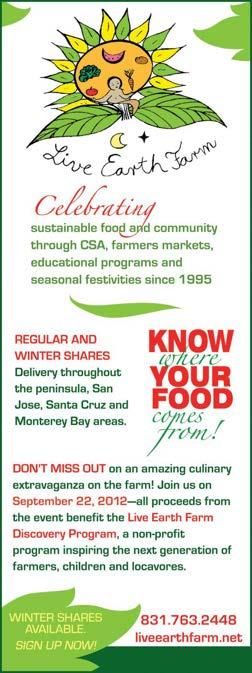
“How many people pick basil off the plant and put it on the pizza as it comes out of the oven? And Dmitri makes the dough from scratch every day,” says Bob Smith, a local resident who gets together with friends and family at Vertigo. “If you don’t get here by 4 pm, it might be gone. Whether you live here or you came to get out of the fog, once you have a seat at Vertigo, time slows down. You look at the mission, you see the rooster poking around and you visit with friends over fresh-roasted coffee and an oven-roasted pizza. It’s fantastic.”
Lisa Crawford Watson lives with her family on the Monterey Peninsula, where she is a freelance writer and an instructor of writing and journalism at California State University Monterey Bay and Monterey Peninsula College.
10 edible monterey bayfall 2012
Vertigo Coffee • 81 Fourth Street, San Juan Bautista 831.623.9533 •
www.vertigocoffee.com
Edible Notables Grow your own
There’s a veggie garden within your grasp
By Anina Marcus
The mid-summer bounty is on full display at Warren Knox’s Scotts Valley home. In his front yard, between bamboo plants and brightly colored ceramic flower pots, stand attractive cedar and redwood planter boxes that, at three feet high, reach most people’s waists. One is filled with marjoram, thyme, parsley and oregano. Larger boxes overflow with squash, cucumbers, watermelons and several varieties of tomato plants. The plants flourishing in one of the boxes, Knox says, come from very expensive seed that, come fall, will yield giant pumpkins.
“These are not your average raised beds,” says Knox, a 56-year-old man with a cheerful face, infectious optimism and a deep pride in his beloved creation, the Knox Garden Box. “They are built like battleships and literally take gardening to a whole new level.”
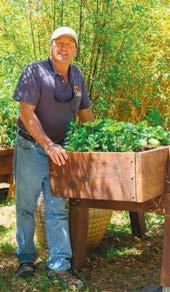
The “new level” that Knox is referring to is not just a wink at his boxes’ unusual height, but also a reference to the mission behind their long legs: to put the joys and healthful benefits of gardening—particularly vegetable gardening— within the reach of as many people as he can.
“I always have loved growing food and just really believed in people being more self-sufficient,” Knox says.
Think no stooping, no kneeling and no knee or back pain. Imagine walking right up to your garden and gliding it on its casters in or out of the shade. This is gardening for everyone—a huge gift to gardeners in wheelchairs or fraught with simple back problems or arthritis in their hips or knees. The boxes also make gardening more practical for the young and agile who are just strapped for time or space for more conventional gardens.
When Knox was a teen, he watched his grandfather, a timber and logging man, kneel to work in his boxed vegetable garden made from old wooden railroad ties. He thought, why not make it easier for granddad, and so at16, he built his first elevated planter box.
With his grandfather’s blessing and $10,000 already saved from odd jobs such as grafting grape stock in the vineyards and cleaning around his dad’s sawmill, Knox started building the boxes during a summer break from Ukiah High School. He invested in supplies, started manufacturing, and then travelled up and down the Central Coast seeking garden centers willing to stock his boxes.
Yet by the time summer ended, no calls. Knox also knew he had to get back to that small business of finishing high school. “You know,” Warren says resolutely, “these things don’t happen overnight.” He was perhaps a little ahead of his time, and eventually ended up with a lucrative roofing business.
Thanks to farmers’ markets, community supported agriculture programs, school gardens and farm-to-table chefs, we are slowly recognizing what Warren’s granddad knew all along: the fresher the tomato, the sweeter and more nutritious, and there’s no fresher tomato than the one you grow yourself.
The boxes come at a price of $35 for an 8-by-24-inch model to $629 for the 4-by-8foot one—more than the cost of your average, simple, wood-framed, ground-level raised bed, if that’s all you want and need.
But aside from their convenience, Knox boxes have other features. They require less water or soil amendments than in-ground gardens, and their good drainage helps eliminate overwatering, They’re rot and insect resistant enough to last up to 25 years, Knox says, and they produce bountiful, healthy plants.
The elevated boxes also offer a bonus that would be valued by anyone who has watched a plant yanked down a gopher hole —a chance to reap your harvest without tangling with the tenacious rodents.
“Why not let the gophers have their way, and I can have mine, too?” asks Knox as he guides a visitor around his gardens. “This way everyone is happy. Right?”
There’s a good chance that Knox’s planter business’ time has come, and that in coming years, Knox will be making a lot of people happy. With aging baby boomers expected to double the population of Americans who are ages 85 and older by 2030, Knox boxes could allow them to keep getting their hands dirty long after their backs and knees have given out.
Anina Marcus has lived on the Monterey Peninsula since she was 2 years old. When she isn’t cooking, she is thinking about what to eat and if she can stave off hunger, she writes.
www.ediblemontereybay.com 11
Photo by Ted Holladay
Edible Notables
Do you know what’s in your food?
Local groups are working to help ensure you do
By Elizabeth Limbach
What do shoppers across the European Union as well as in China, Japan and Brazil know that American consumers do not?
They know whether or not the foods they eat contain GMOs, or genetically modified organisms. Right now, most food labels in the U.S. give Americans no hint of whether a food contains GMOs, but thanks in part to the efforts of concerned citizens here in our region, Californians will be able to weigh in on the matter through a ballot initiative in November.
As part of the statewide push to put a GMO labeling requirement on the California November ballot, 100 volunteers with the group GMO-Free Santa Cruz gathered 15,544 signatures earlier this year in support of the measure. Label GMOs Monterey trained 72 volunteers and collected more than 5,700 signatures.
More than one million John Hancocks were amassed in California overall, successfully qualifying the California Right to Know Genetically Engineered Food Act, now known as Prop. 37, for a vote.
If passed, it will require that foods containing GMO ingredients state as much on their packaging once the law would take effect in 2014.
“As shown by the number of signatures collected…Santa Cruz County residents definitely believe in this issue,” says Mary Graydon-Fontana, one of GMO-Free Santa Cruz’s four co-organizers. She chalks this up to factors like the county’s progressive nature and its history as the “birthplace of organic agriculture.”
Opponents and skeptics of GMOs take issue with their uncertain health and environmental safety effects.

“We are concerned with the plant or meat product that has had its DNA artificially altered in a laboratory by genes from other plants, animals, viruses or bacteria, in order to produce foreign compounds in that food,” explains Colleen Ingram, volunteer coordinator for Label GMOs Monterey and the California Right to Know Committee. “This type of genetic alteration is not found in nature, and is experimental.”
However, she adds that the proposition is ultimately about the public’s “right to know” and does not take a position on GMOs one way or the other. In Graydon-Fontana’s words, “Prop. 37 is a simple, straightforward labeling proposition.”
But if voters pass Prop. 37, the impact could go far beyond labeling, says Ocean Robbins, a Santa Cruz County resident and founder of the Food Revolution Network.
“For the first time, the people get a say in the matter,” says Robbins, noting that labels will likely lead consumers to stop buying— to what degree is unknown—foods that they learn contain GMOs.
“If even 5% or 10% of the population prefers products that don’t contain GMOs, then manufacturers will start to take notice, and demand for GMO foods may go down,” says Robbins. “That’s the power of the marketplace, working with accurate information. But right now, we’re buying food mostly in the dark.”
A slew of nationwide polls show that Americans are leaning away from GMOs: a June 2012 ABCNews.com poll, for example, found that 57% of people say they are less likely to buy products if they know they contain genetically altered ingredients. A whopping 93% say they support GMO labeling. The effect this will have on Monstanto Corp. and other big GMO players has yet to be seen, but the fact that the biotech industry is projected to pour tens of millions of dollars into campaigning against Prop. 37 suggests it fears negative effects from labeling. More than 80% of packaged foods include GMOs, according to most estimates.
Robbins, Ingram and Graydon-Fontana are all optimistic that Prop. 37 will pass, and if it does, California will become the first state in the U.S. to impose such a labeling requirement. Nearly 20 other states have failed at previous attempts, but Robbins predicts that the biotech industry will have less success in swaying Californians.
Whatever happens, the rest of the country is watching. A coalition of nearly 400 businesses and organizations across the country, collectively known as the Just Label It campaign, has filed a petition with the U.S. Food and Drug Administration for GMO labeling at the national level. Proponents of Prop. 37 believe that a mandatory labeling law in California could be the tipping point for labeling efforts across the rest of the country.
Elizabeth Limbach is an award-winning journalist based in Santa Cruz.
For more information, visit www.carighttoknow.org, www.justlabelit.org or find GMO-Free Santa Cruz and Label GMOs Monterey on Facebook.
12 edible monterey bayfall 2012
Photo by Rob Fisher

www.ediblemontereybay.com 13
Note: Fish species marked with # are rated “good alternatives” by the Monterey Bay Aquarium’s Seafood Watch program, meaning they are considered sustainable with reservations due to concerns about the health of their habitats or how the fish are caught or farmed. All other fish listed here are considered “best choices” for sustainability by Seafood Watch.

14 edible monterey bayfall 2012 Fruits: Apples • Asian Pears • Avocados • Blackberries** • Cactus
• Dates • Feijoas**** • Figs • Guavas**** • Kiwis • Kumquats Lemons • Limes*** • Mandarins**** • Melons • Nectarines** Oranges • Peaches* • Pears • Persimmons • Plums • Pluots • Pomegranates • Pomelos**** • Quince • Raspberries • Strawberries Nuts: Almonds • Hazelnuts • Pecans • Pistachios • Walnuts
Beans • Beets • Bok Choy* • Broccoli • Brussels Sprouts* • Burdock • Cabbages • Carrots • Cauliflowers* • Celeriac • Celery • Chard • Collards • Corn • Cress • Cucumbers Dandelions • Eggplants • Endive • Fennel • Garlic • Herbs • Horseradish • Kale • Leeks • Lettuces • Mustard Greens • Okra • Olives
• Orach • Parsnips • Peas • Pea Shoots • Peppers • Potatoes Radishes • Rhubarb • Rutabagas*** • Salsify • Scallions • Shallots
• Sprouts • Squash, Summer and Winter • Sunchokes Sweet
• Tomatillos • Tomatoes • Turnips
•
•
•
•
Pears
Vegetables:
Onions
Spinach
Potatoes
Fish: Abalone (Farmed)
Albacore Tuna (Longline, Troll)
California Halibut (Rod and Reel)#
Lingcod (Rod and Reel)#
Market Squid (Purse Seine)# • Pacific Sardines • Rock Cod, aka Rockfish (Rod and Reel, Purse Seine, Trap)# • Sablefish, aka Black Cod (Bottom Longline, Pots)# • Sole (Longline, Rod and Reel)# Spot Prawns# • White Sea Bass (Troll or Rod and Reel)
LOCAL FOODS IN SEASON
*September
**Only
***October
****November
September, October and November
only
through October
and beyond
only
What’s in Season
The cult of the dry-farmed tomato
The
story behind a deceivingly modest-looking fruit and its irresistible flavor
By Jamie Collins Photography by Patrick Tregenza
Maybe you’ve accidentally forgotten to water your tomato plants when you left for a couple of weeks on vacation and the weather turned scorching. But where you expected to find dead tomato vines, you instead found curling leaves begging for water and beautiful, ripe fruit. Or perhaps you found a volunteer tomato plant, unnoticed yet thriving in your compost pile. Either way, the neglected tomato is smaller, with a noticeably thicker skin, but it has the sweetest, most amazingly condensed flavor you’ve ever experienced in a tomato—much tastier than those you watched with a careful eye and watered regularly. Without deliberately trying, you have happened upon dry-farmed tomatoes, which have attracted something of a cult following among Central Coast farmers, chefs and home cooks.
The technique is not unlike methods for dry farming wine grapes and olives. The theory is that when a plant is stressed by having water withheld from it, the fibrous roots go deeper in search of moisture, creating a stronger root system, and the rest of the plant’s energy focuses on reproduction—creating in the process richly flavorful fruit.
Dry-farmed tomatoes are one crop in which coastal Monterey Bay farmers have captured a niche market because our cool soils are able to absorb enough winter rain to sustain the plants through fall. And that means that when the warm-season crops of our inland neighbors come in, we coastal farmers have something much better than cabbage to offer on our own market tables.
Drought tolerant
The most common seed variety used to dry farm tomatoes is the Early Girl, a reliable and prolific, bright-red hybrid tomato that reaches the size of a golf ball when dry farmed. Unlike heirlooms and their wildly varied colors and shapes, Early Girls are fairly unremarkable in their appearance—except for their distinctively perky round shape.
Early Girl seeds are indeterminate, meaning the plants flower and fruit over a long period of time instead of all at once. This is important if you want to harvest tomatoes throughout the season; determinant seeds are only useful for machine-harvested tomatoes meant for ketchup or sauce.
This is one tomato variety that doesn’t need summer heat in order to be tasty, and a dry-farmed tomato gives a heat-loving heirloom a run for its money in the flavor department. You might think
a dry-farmed heirloom would make the ideal tomato, but most heirlooms are too water loving and too thin skinned for dry farming.
Two exceptions are Stupice and Punta Banda, which both perform well when dry farmed, although they yield smaller fruit than Early Girls. Stupice hails from the Czech Republic and is a heavy producer of bright-red cluster tomatoes. Punta Banda is a meaty red tomato originating from Baja, California, which produces well in poor soil with little heat or water.
Momotaro, like the Early Girl, is a hybrid variety and also thrives when dry farmed. The variety, owned by the Japanese Takii Seed Co., is named for a hero in Japanese folklore and offers a balanced sweet-to-acid ratio and good disease resistance.
I’m personally hopeful that another variety will one day measure up to the Early Girl, as the plant has been owned by Monsanto Corp., the genetically engineered seed giant, since 2005, when Monsanto purchased Seminis Inc., a company that also held the rights to many other common agricultural crops. (The Early Girl is not genetically altered itself, however.)
“The sad reality is that Monsanto owns many of the best varieties out there,” says Christof Bernau, garden manager at the UC Santa Cruz Center for Agroecology and Sustainable Food Systems.
CASFS has trialed many alternatives to the Early Girl, including the Cherokee Purple and Three Sisters heirlooms and the New Girl hybrid, all of which have been good producers, but so far, Early Girl remains the most well adapted and productive choice for the microclimates of the Central Coast.
So for now, the Early Girl is embraced by many local organic farmers, who find it does well given our area’s marine climate, warm sun and, often, water-retaining clay subsoil, Bernau says. What’s more, dry farming is well suited to organic farming in general, because organically enhanced soils are high in organic matter and tend to retain water better, thus conserving water and reducing soil erosion—two goals of any environmentally minded farmer.
In the garden
To grow dry-farmed tomatoes, seedlings should be watered as usual until a strong plant develops and is ready to go from the transplant tray into well-prepared, nutrient-rich coastal soil, which typically has a high water content from winter and spring rains. Thereafter, the plants are watered only until they begin to set fruit, or when extremely hot temperatures would otherwise kill them.
www.ediblemontereybay.com 15
There are a few drawbacks to dry farming tomatoes: lower yield, smaller fruit and calcium deficiency. The calcium shortage can in turn lead to blossom end rot. Still, the increasing demand for these shiny little jewels generates higher prices for the farmers who grow them, balancing out the drawbacks.
Cooking with dry-farmed tomatoes

Dry-farmed tomatoes are great for any dish that would be enhanced by an intense tomato flavor. I’m a fan of halving the tomatoes and roasting them with a sprinkle of Kosher salt until they are partially dry. I use them for just about anything—tossed on salads, made into a spread by mashing garlic and herbs into them or blended into personal-size soups with some cream, sautéed onions, thyme, oregano and a drizzle of balsamic vinegar.
Here is a simple recipe for saving the harvest and keeping the tomatoes in a versatile state.
Roasted Dry-Farmed Tomatoes
Dry-farmed tomatoes (available at many area farmers’ markets) Garlic Kosher salt
Olive oil
Balsamic vinegar
Fresh herbs (basil, oregano and thyme)
Jars for preserving in your refrigerator or freezer

Halve and toss tomatoes with peeled garlic, Kosher salt and olive oil. For soft, juicy fruit that is suited well for blending into sauces and spreads, roast at 200º F for about 1 hour, then brown around the edges by increasing the temperature to 275º F for the last 20–30 minutes. For a firmer, drier tomato that packs well in olive oil for future use, roast at 150º F or as low as your oven will go for 4–6 hours. Edges should be slightly browned.
Once cooled, dip the tomatoes in a bath of balsamic vinegar and then layer into jars with the roasted garlic, as well as fresh basil, thyme and oregano. Pour olive oil over the herbs and tomatoes until everything is submerged. Top the last inch or so with balsamic vinegar. Store in jars at room temperature for three days and then refrigerate.
As long as the tomatoes are submerged in olive oil, they will last for months in the refrigerator. They will keep even longer by freezing either in their jars (leaving two inches of head room for expansion) or in freezer-safe bags.
Jamie Collins of Serendipity Farms has been growing organic row crops at the mouth of Carmel Valley for more than 10 years. She distributes her produce through a CSA, u-picks and farmers’ markets.
16 edible monterey bayfall 2012





18 edible monterey bayfall 2012
Teachable Moment
Reaching at-risk youth through food
By Deborah Luhrman
Harnessing the considerable power of sustainable food and agriculture here on the Central Coast, five local nonprofits are reaching out to marginalized kids and helping them become successful adults.
The oldest of these programs is Rancho Cielo, which occupies 100 acres in the foothills east of Salinas. It was founded in 2000 to help young people from low-income families who were in trouble with the law or just having difficulty making it through high school.
“This year we’ve had two of our kids shot in the head near their homes,” says Executive Director Susie Brusa, explaining that Rancho Cielo is a safe haven from street violence. “It’s hard to focus on a math test if you are worried about getting stabbed, on your break,” she adds.
In addition to safety, teens get individualized academic instruction leading to a high school diploma and job training. Originally students were trained in the construction trades, but two years ago Rancho Cielo opened the Drummond Culinary Academy, now headed by Chef Paul Lee, to take advantage of all the job opportunities in the hospitality industry on the Monterey Peninsula.
“The way we measure success is getting a job and keeping it, or going on to higher education and staying out of trouble,” says Brusa. Curriculum for the culinary academy comes from the National Restaurant Association, so graduates receive a nationally recognized certificate and can work anywhere in the country.
Restaurateur Bert Cutino, chef/owner of Monterey’s Sardine Factory, has successfully involved many of the peninsula’s top chefs in the program, allowing students to be exposed to different cooking styles. One has even ended up working in his kitchen.
Join us!
You’ll have a chance to meet some of these groups and learn more about them at Edible Monterey Bay’s First Anniversary Dinner at Live Earth Farm in Watsonville on Saturday, Oct. 13 at 4:30pm. (Watch our RSS, Twitter and Facebook feeds for more.) The kids will be displaying the great skills they’ve learned as they serve dishes that they helped create, with food they’ve grown themselves. And please consider helping them raise money for their programs by attending their upcoming benefits, which are all listed at the end of this story.
Starting in October, the culinary academy will begin serving dinner to the public on Friday nights. Rancho Cielo students do all the cooking and serving and even grow flowers for the tables themselves. Dinners are a good value at $15–$25 for three courses and are a great way to show support for a worthy program.
Holistic style
Vocational training in culinary arts is part of a “whole systems” approach to educating youth at Lightfoot Industries and Lifestyle Culinary Arts’ after-school programs, both in Santa Cruz County.

“Vocational training has long been lost in this country,” says Lightfoot founder Carmen Kubas. “Kids are not gaining entry-level work skills.”
The Santa Cruz County Office of Education is very supportive of vocational training and is trying to fill the gap with courses in everything from aquaculture to engine repair. Their culinary arts program, taught by Chef Andrea Mollenauer of Lifestyle Culinary, attracts about 90 students a year. They attend class once a week for four hours and earn Cabrillo College credits.
www.ediblemontereybay.com 19
Edible Schoolyard
Rancho Cielo graduates prepare a pop-up artichoke feast held by Pezzini Farms and Casanova restaurant in June 2012.
Photo by Rob Fisher
“I try to mimic what it is like to be out in the field, with lots of accountability and lots of long, hard, hot days—like a real kitchen,” Mollenauer says. Students also gain real life experience, by cooking and serving at catered events for nonprofit organizations.
“The fact that kids are working with food is a very nurturing, therapeutic and creative experience,” says Kubas, who hopes to someday open a Lightfoot Café with her students.
Combining her experience as a teacher, restaurant consultant, parent and soccer coach, Kubas has developed a three-year comprehensive program that includes a wellness component where students study yoga, nutrition, meditation, life skills and what she calls sustainable professional development or “soul craft.”
“We try to identify what their soul craft is—what lights their fire —then identify the education pieces that are needed, set goals and go for it!” Kubas says.
Until the café opens, Lightfoot Industries will continue to hold supper clubs at various locations around Santa Cruz and bake and market their wholesale line of luscious gluten-free pies (including sweet potato, Meyer lemon chess and strawberry-balsamic-chèvre). Students do all the cooking and serving. “It’s a big win-win,” she says. “The community gets to see these kids in a different light, and the kids get to interact with people they don’t normally meet.”
Last summer she and the students worked on the farm at Esalen Institute, harvesting and preparing food. “It goes a long way towards connecting them to the local ecosystem and eventually helps make them better stewards of the land,” she says.
From seed to table
Hands-on learning, rather than sitting in a classroom, is key to all five food programs. At Food, What?! in Santa Cruz—part of the nonprofit Life Lab located at the UCSC Farm—about 50 low-income high school students grow and cook their own food. To make pretzels or pizza, they go through the entire process: planting and growing wheat; threshing it; grinding it; and finally preparing the food and eating it.
“You’re outdoors and physical, and that works really well with a lot of kids who have struggled in school,” says Director Doron Comerchero. “It’s also a beautiful and safe place, where youth can take the first steps in developing positive self-esteem.”
During the summer, about half the students are hired to run the organic Food, What?! farm. They take high-quality produce home to their own families, helping cut down on grocery bills and sharing what they have learned about eating vegetables on the farm.
Excess produce is sold at Gault Elementary School on Thursdays at a low-income farm stand that will operate until Halloween. “The farm stand provides youth with transferable job skills, like setup, display and accounting,” says Comerchero. “And they are providing a community service.”
There are four applicants for every place in the popular Food, What?! Program, and Comerchero hopes he will soon be able to expand into the Watsonville area where the need is great. Food, What?! is a member of Rooted in Community—a national, grassroots network working for youth empowerment through gardening and food justice issues.
“Young people are craving meaning, and these are fundamental pieces,” he adds. “We could run a soccer program, but food is meaningful because everyone eats.”
Since the Monterey Bay area is such a hotbed of sustainable agriculture, it may seem that these programs are especially suited to our area. But there are dozens of them throughout the country, and some people think even more are needed here.
Jered Lawson, executive director of the 14-acre Pie Ranch in Pescadero, believes every high school should have its own farm and thinks just about any subject can be taught through agriculture.
At Pie Ranch—also a member of Rooted in Community— about 1,000 students from three high schools visit the working farm each year. They learn valuable lessons about where and how food is grown by planting wheat and cover crops in the fall, harvesting citrus in winter and sowing seeds in the greenhouse in spring.
Subjects like English, math and American politics are also taught using the farm as a focus. “We look at national policies that shape our food system, like the fact that the SNAP (food stamp) program is threatened in Congress,” says Lawson. “We want students to think about the fact that they have a voice.”
During the summer, 15 students are selected for the Home Slice program, a paid job that includes leadership training and job skills experience. Students help with Pie Ranch’s CSA program and its weekend farm stand (Saturdays and Sundays noon–6pm).
“Our overall goal is to inspire people to be more excited about food and farming and to be more conscious members of society who use their dollars to support a healthier food system,” he says.
Deborah Luhrman was once the Santa Cruz County bureau chief for Channel 46 news. She has been traveling the world and spending too much time on airplanes for the past 25 years. So she returned to Santa Cruz to grow a garden and write about local issues.
Get Involved
Rancho Cielo, Salinas Dinner at Rancho Cielo every Friday night from 6pm, starting October 5. Advance reservations required, call 831.444.3521. www.ranchocieloyc.org
Family Play Day at Rancho Cielo Saturday, September 2 from 8am–3pm • 5k/10k races, fun run, hikes, rock climbing, barbeque and live music. Tickets: $12
Pie Ranch, Pescadero The Search for Good Food – 4th annual fundraiser • Saturday, September 22 at 3pm • Explore the farm, take part in a scavenger hunt and enjoy a family-style dinner prepared by Google chefs, followed by live music and dancing in the barn. Donation: $200. www.pieranch.org.
Food, What?! Santa Cruz Dinner Benefit on Food, What?! Farm • Saturday, October 6 • You’ll experience youth-grown and-prepared deliciousness plus stories of empowerment and food justice. www.foodwhat.org
20 edible monterey bayfall 2012

www.ediblemontereybay.com 21
 by Alan Lovewell
by Alan Lovewell
“Today the gal at the Monterey Credit Union asked me if ‘Local Catch’ was a dating service!” wrote Oren Frey, co-founder of Local Catch Monterey Bay, in his weekly email to the group’s members one day last spring. “I told her we were all about fish.”
By Pete Rerig
On the Bay: Stan Bruno gaffing a chinook salmon.

Whether the question itself was intended as a pick-up line, we’ll never know. But the truth is, Local Catch—a wildly successful community supported fishery program that distributes fish in much the same way that a CSA provides vegetables—is about much more than just fish. It’s also about connecting people who care about seafood to its source, and to each other. And ultimately, it’s about protecting our oceans and the sea life and fishermen who depend on them.
“The ocean is a public commons,” says Local Catch co-founder Alan Lovewell. “If there’s anything to come together over, it’s the oceans and the air.”
www.ediblemontereybay.com 23
Out to Sea Catch This! Local Catch connects us to our bay —and attracts an ardent following
Photo

24 edible monterey bayfall 2012
Foodie confab: a Local Catch potluck.
Photo by Ted Holladay
But how to do that? Lovewell notes that there is nothing more concrete to connect us to the sea than sitting down and eating fish.
The problem is that the connection between the eater and the sea often ends with the fish—average consumers have no notion of who catches their fish, or how. They may even blame fishermen for overfishing, which is really much more a failure of society to effectively regulate and manage the fisheries, than the fault of fishermen, Lovewell says. And that makes fishermen a key link between the oceans and the rest of us—and uniquely positioned to help consumers grasp that through our choices, we all have an impact on the oceans.
“Fishermen are out there on the ocean—they’re engaging with it and they’re part of it,” Lovewell says. “When they bring us fish to eat, we become a part of that cycle, that sphere of influence over the oceans.”
Making it all happen
Greg Young is up to his elbows in squid. Literally. Six hundred pounds of it to be exact, all pulled from Monterey Bay just hours ago. And while most of us would be overwhelmed at the prospect of dealing with it, Young—the procurer and processor of Local Catch’s weekly shares—takes it all in stride. For him it’s just another day at the office, and the squid will soon be zipped into plastic bags and ready for delivery to Local Catch members—one bag for small shares, and two bags for family shares.
“We’re off to a great start,” Young says, beaming. “We’ve packed a thousand pounds of sand dabs this year, all hook-and-line caught. It was also an amazing season for Dungeness crab and Chinook salmon—locally smoked—as well as sablefish, Pacific herring, abalone, oysters and white sea bass out of Capitola.
“And after seeing the excitement and enthusiasm of our customers, I truly believe that Frey and Lovewell have created what will be the future of fishing for Monterey Bay.”
A commercial fisherman himself as well as owner of Sandabs restaurant in Scotts Valley, Young is so excited about Local Catch that sometimes he does the work for free. Now that’s dedication.

In fact, as this issue of Edible Monterey Bay went to press, Local Catch had signed up 320 members, 60% more than the 200 that they originally sought for their first year—and a lot of the members have come in through word-of-mouth spread by thrilled subscribers.
When asked about the special recipe for success in their inaugural year, Young is quick with his response.
“We approach sourcing for Local Catch in the same way someone would go about placing any specific order for a product. We tell fishermen what we need ahead of time, and how much. The fishermen know they have a guaranteed sale. In essence, we’re pulling only what we need from the water, and we’re assured that our customers will be happy.” This, Young notes, helps prevent overfishing.
Also, by creating a new market for seafood that is caught with sustainable practices and minimizing the number of middlemen between the fish and the customers, Local Catch is structured to incentivize sustainable fishing while providing the best price possible to local fishermen.
Spreading the word
While Young is filleting and bagging the seafood that will make its way into shareholders’ blue insulated bags each week, Frey is also hard at work, albeit on the polar opposite side of the business. From his home in Pacific Grove, he’s working tirelessly on the member newsletter, which each week bears the surprise of what has been biting in sufficient quantities for Local Catch to deliver to its members—as well as profiles of the week’s fish and the fishermen who caught it, recipes for the featured fish, and videos of the fishermen catching it and local chefs preparing it. He also includes the survey results that let him know what’s working and what isn’t.
“I love getting feedback from our members,” says Frey, who notes they are being adventurous with their cooking. “It’s clear that a lot of our members are stepping out of their comfort zones, using their weekly shares to be creative. We get photos from people, showing how proud they are of what they’ve prepared, and they tell us about how Local Catch has become a ritual of sorts. Some even com-
www.ediblemontereybay.com 25
Local Catch founders Oren Frey and Alan Lovewell.
bine their shares with other members and have big midweek feasts. That’s really gratifying.”
What members seem to appreciate most, says Frey, is the support they receive from Local Catch. “We’re doing everything we can to educate people, to give them new ideas for eating seafood within a framework of sustainability. Without a doubt, our members realize how much better this seafood is versus the stuff they get in the supermarket. And when they read our fishermen’s online profiles and see the videos of their fish actually being caught, the enthusiasm is tremendous.”
Of course, such rousing success brings new goals for Local Catch’s second year.
So Frey and Lovewell, who started Local Catch while they were both NOAA Sea Grant Fellows, are tweaking their approach.
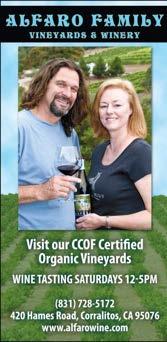
“We’re trying to get away from exact weights” for each week’s share, Frey says, so that members can receive a maximum variety of seafood, including a mix of expensive and inexpensive choices, with the cost to Local Catch evening out over the course of each month.
For example, Local Catch delivers an ample 1 to 2 pounds of fin fish, like halibut, salmon, sablefish and albacore, per small share (two to three people, $20). Family shares (four to six people, $36), contain 2 to 4 pounds of fish.


When Dungeness crab was in season in the first year, two crabs were allocated to the small share, sending the weight up to 4 pounds, and when the seas were too heavy for fishing, small appetizer portions
of highly expensive farmed abalone were provided a couple of times. Oysters were also procured from Tomales Bay farmers on some stormy weeks.
“We’ve also learned how to be more precise about what we’re able to provide to members. Moving forward, we’ll be more aware of what is available when, and how weather conditions affect what’s caught. “The Pacific herring is a good example—it’s hard to find and the season for it is very short. But it’s also very sustainable and a great choice for us.”
Chefs at high-end San Francisco Bay restaurants such as Quince and Chez Panisse put herring on their menus when the harvest came in this past winter, but Local Catch found that some of its members had difficulty cooking it. “It’s oily and fishy, and not the easiest thing to prepare. But again, a lot of gratitude came our way for the opportunity to try something different.”
In addition to running Local Catch, both Frey and Lovewell have other jobs in fisheries protection—Frey, with the Monterey Bay National Marine Sanctuary, and Lovewell, with the West Coast Governors Alliance for Ocean Health—and if there is one element of Local Catch’s program that Frey and Lovewell would like to improve, it’s putting the fishermen more front and center.
“We really want them to take ownership of the program, to be more involved with the members,” Frey says. “The fishermen who already provide us with products see what a great thing a CSF is. We want to connect their passion with the customers, who have gained a
26 edible monterey bayfall 2012
Fisherman Christian Zajac: Artist and Environmentalist




The ocean is Chris Zajac’s muse. He makes his living on it, plying the waters for black cod and salmon, sablefish and crab. But it also holds another allure, one he indulges through dramatic oil paintings of the seascape. “I love fishing, and I love art…not many guys in my profession can say that,” says Chris, who was born in Rome, Italy, to artist parents. “The ocean has always held a special attraction for me, even though the Mediterranean and the Pacific couldn’t be more different.”
As one of the fishermen supplying Local Catch Monterey Bay, Chris’ passion extends far beyond the bow of his 30-foot, 1932 Monterey wood-hull boat originally built for Joe DiMaggio’s father. “Fishing here is so incredible, so fulfilling,” he says. “Even people I know in Europe can’t comprehend just how fresh our local seafood is, or the vast resource we access. The biomass of our water is beyond compare.”
And yet, Chris—who can often be spotted tooling around Santa Cruz in his “art car” outfitted with a 6-foot orca fin—knows that public perceptions of local fishermen don’t always paint a rosy picture. “Every fisherman I know isn’t looking to become a millionaire by abusing the local fishing grounds. We’re well aware of the dangers of overfishing, and it’s important for people to know that we aren’t callous individuals who don’t care about the environment. Local Catch helps with that, helps educate the public and gives us a connection to those who support us.”
Utilizing solely hook-and-line methods, Chris is very sensitive about the carbon footprint he leaves in his wake. “A lot of what I do is about numbers,” he adds. “I look at how much of an effect on the environment I’m having for the amount of fish I bring to someone’s table. That’s the key—being responsible. I move from fishing ground to fishing ground, making sure I’m not overfishing a particular spot. But in the end, we’re all at the mercy of the weather,” he notes, alluding to a recent period of cold local waters. “Everything out here is cyclical, including what fish is available when. People who sign up for a CSF realize this, and I think they’re ready for both the uncertainty and the great surprises that come each week.”
www.ediblemontereybay.com 27
Photo by Alan Lovewell
huge amount of appreciation for what they do. We also want to use their excitement to recruit new fishermen who share the same mindset.”
Weekly wonders
It’s Tuesday outside the Pacific Grove Adult Education Center on Lighthouse Avenue, and Cyndra Bradford eyes this week’s share—a bag of Monterey Bay whole squid. “I’m a little nervous,” she says, unsure about how she’ll clean and cook the alien-looking things. “I’ve only been a member for about a month, but I already love pickup day. You never know what you’re going to get—it’s almost like catching a fish yourself!” she says, laughing. Month-long members Ed Midel and CeCe McCoy agree, adding that this is also their first attempt at home-prepared squid. “Local Catch gives such great support, though, so we’re never really worried about what comes in the weekly share,” says CeCe. “It’s such a great operation, and we just love what they’re providing.”
Another member, Alexi Hernandez, is not trepidatious in the least. “I’m looking forward to seeing what we can do with this,” he says, smiling and noting that his wife, Lupita, works at Hopkins Marine Station, a job that provided the impetus for their joining Local Catch on day one. “I think we may stir-fry it or maybe make a salad.” Asked what his favorite aspect of the program is, he says: “The variety and the fact that it’s all sustainable. And the price—you can’t get seafood this fresh and local for what we pay.”
Later, Vicki and John Pearse—two marine biologists wholly devoted to utilizing local seafood and produce—say the week’s delivery of squid was a true delight.

“We used a recipe given to us by our friend Isabella Abbott,” says Vicki, who also works at Hopkins Marine Station. “We like light recipes for squid so this was perfect —a little garlic, green onions, shredded carrots, cilantro from our garden, white wine and breadcrumbs to sop up the liquid. Sauté quickly in a hot pan, and that’s all you need.” The ardent locavores—and Local Catch members for the past four months—paired their dish with brown rice and a medley of vegetables procured from the farmers’ market.
“Local Catch Monterey Bay is more than just a fish market,” Vicki says. “It’s an educational resource, teaching people how to eat more responsibly. And with all the added information—learning about our fishermen, where the fish come from, how to cook different recipes—the whole experience of being a member is just exceptional.”
“We love everything about the CSF,” says John, professor emeritus of ecology and evolutionary biology at UC Santa Cruz. “We especially like the contact with the fishermen, and the perspective we gain through that contact. Everyone devoted to eating fresh, sustainable seafood should experience that connection.”
The former managing editor of Charleston magazine and a lifelong foodie and history buff, Monterey resident Pete Rerig works at Museum of Monterey and as a freelance writer.
Local Catch Monterey Bay • www.localcatchmontereybay.com
For related stories, see p. 27 and p. 30.
28 edible monterey bayfall 2012
This man cuts your fillets: Greg Young, Local Catch’s procurement and processing guru.
Photo by Ted Holladay

Other fish in the sea
H&H Fresh Fish also offers a local CSA-style fish program
Local Catch Monterey Bay is the largest subscription fish delivery program in the region, but it’s not the only one.
Lifelong fisherman Hans Haveman and partner Heidi Rhodes launched what they call a “Community Supported Seafood” program last year, and as this issue of Edible Monterey Bay was going to press, it had signed up more than 100 members.

The program is an outgrowth of Haveman and Rhodes’ 10-year-old family fish distribution business, which has long supplied Santa Cruz and San Francisco Bay-area customers with fresh, sustainably caught fish via farmers’ markets and a catering company.
“This is your spot for sustainable fish,” says Haveman. “Everything we catch is completely sustainable, in my opinion.”
H&H’s program aims to deliver a relatively precise half-pound portion per person, and offers choices ranging from one-serving deliveries (0.5 pound, $10) to six (3 pounds, $45). For members who don’t want to look a squid in the eye, H&H tries to include in their basic shares fish that are familiar to home cooks, like salmon, halibut, sole and sablefish. It allocates the less familiar fish (like squid, spot prawns and whole sardines) to buyers of H&H’s “adventurous foodie” option.
“It makes me excited because it makes people aware of other things out there, including some old-world recipes and techniques,” says Haveman of the “adventurous” shares.
H&H delivers its fish subscriptions to drop points in Santa Cruz and Santa Clara counties, and will make house calls for an extra charge.
Looking to the future, Haveman would like to supply seafood to more local restaurants, while Rhodes would like to expand the CSS to San Francisco and start offering it to large companies, much as Google offers a CSF to its employees.
— EH and SW
Elaine Hesser is a lifelong foodie who’s been cooking since she was six. She loves to write and educate others about seasonal, local food choices.
30 edible monterey bayfall 2012
H&H Fresh Fish • www.hhfreshfish.com
H&H: Hans Haveman and Heidi Rhodes.
Photo by Ted Holladay



www.ediblemontereybay.com 31
Back of the House For the Love of Italy
La Posta restaurant reflects the passions of two globetrotting women
 By Deborah Luhrman Photography by Ted Holladay
By Deborah Luhrman Photography by Ted Holladay

32 edible monterey bayfall 2012
Chef Katherine Stern was on a backpacking trip around Europe when she fell in love with Italy. Soon afterwards, she fell in love again. “I met my husband in a castle,” she says of the fairy-tale romance that began in southern Tuscany at the Castello di Potentino. She was a volunteer, picking grapes and olives in exchange for room and board. He was a Scottish carpenter working to restore the medieval palace. So she decided to stay on for a few more years, learning everything she could about Italian food in the meantime.
Having trained at the Western Culinary Institute in Portland, Katherine first worked abroad as chef for the owners and work crews at the Italian castle, which hired her after realizing that their fruitpicking volunteer was a chef. She then attended a Slow Food academy and completed several stints at hill town restaurants, made cheese in Abruzzo and ended up working at the two-Michelin-star Caino restaurant in Montemerano—another Tuscan hill town not far from the castle.
luck,” says Boyle. “She is a serious person who has very clear ideas about how things should be, and I had a quick affinity for her.”


Women in charge
At just 5’1” and always sporting her short ponytail, 34-year-old Stern could easily be mistaken for someone half her age. But on her first night of trying out at La Posta, she arrived in her chef’s whites with her own knives and walked right into a kitchen full of men, taking charge with gentle, small suggestions.
She is one of the only female head chefs in the Monterey Bay area but cannot understand why. “It’s a mystery why there aren’t more women head chefs. I’ve never felt discriminated against, but the environment might be challenging for some women. It’s fast paced and you can’t let things affect you too much. There are going to be a lot of things said. You have to be pretty tough.”
Cruz, felt the pull of Italy at an earlier age. “My fascination started in high school when I fell in love with Italian shoes,” she says. “Then in college I was a music major and discovered opera. Later I found out about Italian wines.”
Boyle owned a winery in Paso Robles in the 1980s, then left to work as general manager for Bonny Doon Vineyard—a job that allowed her to travel the world trying fine wines. Ten years ago, she opened Soif restaurant and wine shop to showcase the lesser-known European wines she loves. But she longed to open a food-centric Italian place, so in 2006 she started La Posta, in a building that was once a post office for the Seabright neighborhood near the yacht harbor.
The two women met three years ago, after La Posta’s first chef quit. “Finding Katherine was another piece of unbelievably great

She also thinks the female cooking style is a bit different from men’s. “It’s calmer food; sometimes there’s a lot more ego in male food,” she says. “For example, I feel absolutely fine with a dish that only has three ingredients, letting those ingredients speak and not feeling like I have to add more. But some people want to throw lots of things into a dish, and that masks some of the flavors.”
Boyle says she had no apprehension about hiring a petite young woman to run the kitchen. In fact, the front-of-house manager at La Posta, Sarah Simms, is also a woman. “I didn’t plan it. That’s just the way it worked out,” she says.
But she agrees with Stern that the role of head chef is not for everyone.
“Restaurant work is hard. It’s hot, close and heavy. You’re always dealing with the public, which can be unpredictable, and often there is conflict. Rough and tumble can happen.”
www.ediblemontereybay.com 33
Restaurateur Patrice Boyle, who owns both La Posta and Soif in Santa
Chef Katherine Stern with her herbs.


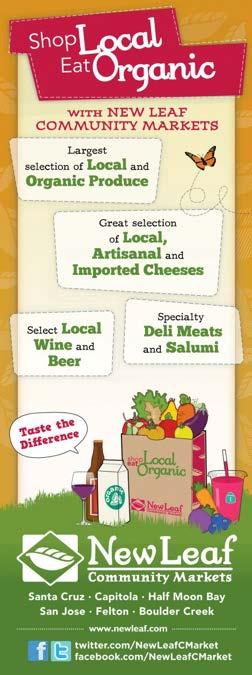
34 edible monterey bayfall 2012
But not only does Stern love her work, she also seems fully at ease. Watching her in action makes you easily imagine that she’s channeling a sprightly little Italian grandmother.
Behind the scenes
In the long, narrow kitchen at La Posta, Katherine exudes a sense of calm under pressure. On a recent Friday night, orders started pouring in at 6pm. She studied them carefully, patting beads of sweat from her upper lip with a kitchen towel. She then turned to the stove, tossing a skillet of pasta, spinach and sugar snaps over the flames before adding a touch of mint and crème fraîche.
To her left, Ruben Serna assembled pizzas, while his brother Rodrigo shaved thick slices of summer squash and mixed them with fennel, purslane, pine nuts and vinaigrette for a salad. A fourth cook, J.J. Gonzales, filled in as needed, and they danced around each other without missing a beat, sliding plate after plate over the marble serving counter.
The food that La Posta’s kitchen turns out is simple, yet elegant, with a strong Italian sensibility. Katherine makes everything
Retro vibe
The 55-seat dining room at La Posta echoes the simple Italian flair of its food. It’s reminiscent of a bustling, 1940s-era trattoria, and the sounds of happy diners bounce off yellow, Venetian-glazed walls as do classic jazz tunes from the stereo. Sepia-toned photos of Italy lean against the walls. Simms, the manager, dresses in vintage chic with fishnet stockings.
The only reminders that it once was a post office are three rustic redwood posts that hold up the roof and whimsical chandeliers made of old travel postcards hanging over the 6-seat bar.
My favorite dish on that busy Friday night was smoked black cod salad, with peas, fava beans, pickled carrots and fingerling potatoes—a creative pairing of sweet, sour and smoky flavors, along with the absolute freshness that favas bring to the dish.
We also tried Katherine’s tasty and healthy version of lasagna made with leaves of an old English herb called lovage, chicken and summer squash. Among the gourmet pizzas available was one made with nettles,
fresh daily, including homemade pasta and charcuterie. The menu changes all the time, depending on what strikes her fancy on twice weekly trips to the farmers’ market—in downtown Santa Cruz on Wednesdays and at Cabrillo College on Saturdays.

“In Italy, everything is very local. They only use what is available to them,” she explains. “We were living only an hour from the sea, but they didn’t eat fish. You only got meat.
“So I feel like I am doing the same thing, using what is available locally, and if it is not a traditional Italian item, that doesn’t matter because we are in California,” she adds.
mozzarella, artichokes and Cerignola olives and another featuring summer squash, squash blossoms, Fontina cheese and prosciutto.
She supplements farmers’ market fare with organic produce delivered by local farms, including Happy Boy, Freewheelin’ Farm and Tierra Madre. Forager Freddy Menge supplies mushrooms in season, as well as rare varieties of apples, currants and sour cherries. Free range meats are sourced at Fogline Farm in Soquel, and fish is caught sustainably. There is a garden box growing culinary herbs by the kitchen’s back door and a small chicken coop with three old hens, which stopped laying eggs last summer. Stern is looking for a home for them and has no intention of putting them in a soup.
La Posta just started its own kitchen garden, shared with Soif, in a large backyard on the Westside of Santa Cruz. A fourth woman
www.ediblemontereybay.com 35
Getting ready to open: La Posta owner Patrice Boyle.
is in charge, farmer Alice Lee, who also manages the garden at Main Street Garden Café in Soquel. She already has started planting winter greens and herbs for the two restaurants. Katherine is looking forward to having a steady supply of hard-to-find edibles—especially red frill mustard, which will be debuting on the menu this winter.
Vagabond Career
Although deeply influenced by her time in Italy, Stern is originally from Los Gatos and went to Campbell High School. Her father was in the wine business and introduced her to fine dining at an early age.
“I remember going to Café Beaujolais in Mendocino and being very excited about ordering acorn squash soup because I thought it was made with acorns,” she says. “I was always interested in trying out new things, and I was always hungry.”
She spent a year in college but dropped out and took a shot at culinary school. “I never loved the academic environment, but culinary school was exciting and it was like, ‘Oh! This is what I should be doing.’”
On graduating, she worked at the Kimpton Hotel Vintage Plaza’s Pazzo Ristorante in Portland and spent two years at Gabriella Café in Santa Cruz before heading to Europe. After three years in Italy, she returned to the States to work at the seasonal Italian restaurant Quince in San Francisco and then took off again, following her husband and working first at a Chez Panisse-style restaurant in Wellington, New Zealand and then in a rural inn on the west coast of Scotland, famous for its Loch Fyne oysters.
Katherine still seeks inspiration through traveling and eating out, especially in San Francisco. On her days off, she heads for restaurants like flour + water, which specializes in pasta and pizza. She also enjoys a new restaurant on Valencia Street in the Mission District called Locanda—which is part of the Delfina group of restaurants specializing in the cuisine of Rome.
But maybe the wanderlust is wearing off. Nowadays, she is happy with the subtle adventures of living and working in the Seabright neighborhood of Santa Cruz—where high-quality ingredients are plentiful and she can ride her bike to work.
Sformato of Winter Squash with Roasted Figs and Toasted Hazelnuts
Courtesy Katherine Stern, La Posta in Santa Cruz
A sformato is a variation on vegetable timbale. The word comes from the Italian verb “sformare,” which means “to unmold.”
1 winter squash (butternut, red kabocha or large delicata are all good options)
1 quart whole milk 3 ounces flour 2 ounces unsalted butter 1 bay leaf Nutmeg Salt and pepper
½ cup Parmesan cheese, freshly grated 6 eggs
6 to 8 fresh figs
½ cup hazelnuts, toasted and roughly chopped Few handfuls spicy salad greens (arugula, peppercress, watercress, etc.)
Olive oil
Preheat oven to 375° F.
Cut the winter squash in half. Drizzle it with some olive oil and season with salt and pepper. Place cut side down on a baking sheet and roast in the oven until tender, about 45 minutes to 1 hour, depending on the size of the squash. Let cool. Turn the oven down to 325° F.
Melt the butter in a heavy bottomed pot. Add the flour and stir to combine. Cook the roux until just fragrant but not browning. Add the milk a little at a time while whisking. Be sure to whisk well to avoid any lumps. Once all of the milk has been incorporated, add the bay leaf. Continue cooking over medium heat, whisking constantly until the béchamel comes to a boil. Boil for 1 minute and then remove from the heat. Season with salt, pepper and a few gratings of nutmeg. Set aside.
Scoop all of the flesh out of the squash and puree in a food processor until smooth. Whisk the squash puree into the béchamel, then whisk in the eggs, one at a time, followed by the Parmesan cheese. Taste and adjust seasoning as necessary.
Butter and flour 8 ramekins. Fill the ramekins about ¾ full of the sformato mixture. Place the ramekins in a baking dish and add hot water to about halfway up the sides of the ramekins. Bake for 45 minutes to 1 hour or until set.
Remove the ramekins from the baking pan and set to cool on a rack.
Turn the oven up to 425° F.
Cut the figs in half lengthwise. Heat a heavy-bottomed sauté pan over mediumhigh heat. Add a knob of butter to the pan and lay in the figs, cut side down. Allow to sizzle for a few seconds, and then place the pan in the hot oven. Roast the figs for a few minutes until golden but not falling apart.
Loosen the edges of the sformato with a paring knife. Unmold onto individual plates. Dress the greens with a little olive oil and season with salt and pepper. Arrange the roasted figs around the sformato. Sprinkle with the toasted hazelnuts and scatter the greens around the plate.
36 edible monterey bayfall 2012
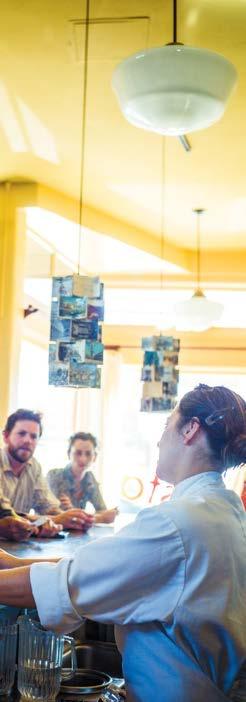
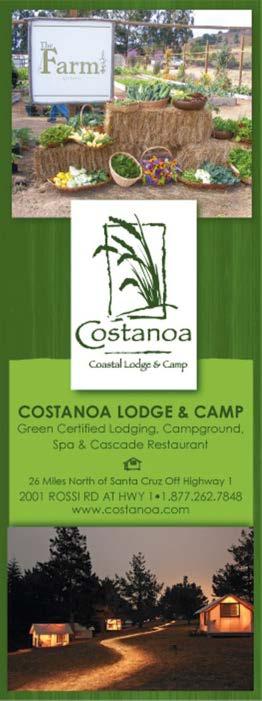
www.ediblemontereybay.com 37








38 edible monterey bayfall 2012
liquid Assets
I’ll have a beer with that

Local chefs ditch the wine to create beer-centered dinners
by Deborah Luhrman Photography by Patrick Tregenza
Santa Cruz Mountain Brewing: Not your average sandwich and a beer.
“I love beer and I love food,” says brewer and beer evangelist Kevin Clark. Reason enough for him to start a popular monthly series of beer and food-pairing dinners at Peter B’s Brewpub in Monterey, where 30-year-old Clark reigns as brewmaster. Other local restaurants—like Point Pinos Grill in Pacific Grove—have also tuned in to our growing passion for craft beer and started their own regular pairing dinners. At the same time, places like Santa Cruz Mountain Brewery are getting into food, both pairing and cooking dishes with beer. And the fall calendar of beer and food events is about to get busier, with Monterey’s new Bacon, Blues & Brews joining the Monterey Beer Garden and Santa Cruz’ Sausagefest. (Continued on p. 41)

www.ediblemontereybay.com 39






40 edible monterey bayfall 2012
It was probably just a matter of time before beer lovers and foodies decided to get together. But experts say craft beer goes especially well with food, and its growing popularity is a real bright spot for the brewing industry. While beer consumption declined nationally in 2011, the Brewers Association says craft beer grew to 5.7% of total consumption, surpassing 5% for the first time ever. And California ranks No. 1 in the nation with nearly 300 microbreweries producing endless local varieties of lagers, ales and stouts.
The floral and fruity characteristics of hops used in craft beer are one reason it pairs better with food than your average can of Bud. “The kind of hops makes a big difference,” says Clark, who has traveled the world, sampling brews. “In New Zealand, hops are bright and citrus-y; U.S. hops are big, full and in your face, just like with wine; and European hops are warm.”
Unusual seasonal ingredients that often go into craft beer are also a factor. For example, Clark found that the red raspberry ale he made last summer paired really well with raspberry-infused cheese. A pumpkin ale he is getting ready to release in October might be paired with pie.
Beyond Hot Dogs
When it comes to food that pairs well with beer, “Bacon is a nobrainer,” says Dory Ford, executive chef at Point Pinos Grill and AQUA TERRA Culinary. “You could just put a heap of bacon on the table and drink your beer and eat the bacon,” he says with a laugh.
Fortunately, his beer-pairing dinners and those prepared by Chef Jason Giles at Peter B’s are a lot more sophisticated. They start with the lightest brews to accompany appetizers and flow to medium-bodied ales with the main course, followed by heavier, richer stouts at the end of the meal—sometimes with dessert.
“Pretty much anything that is crispy, fried, golden brown or rich in umami tends to go well with beer,” says Ford, who once created a gourmet pairing dinner, working different cuts of pork into five delicious courses, ending with bacon, chocolate and cherry bread pudding with candy cap mushrooms.
After those criteria are met, the search is on for nuances in the beer that can be reflected in the food so that the pairing brings out the best in both the drink and the dish.
The pairing Ford is most proud of was a savory beef pie, made with braised beef cheeks, mirepoix, gravy and mushy peas, and served with malty, medium-bodied Black Prince Porter from English Ales Brewery in Marina. “We got that one just right,” he recalls.
Rich stouts are often paired with desserts that play up their subtle chocolate or coffee notes. Peter B’s is working on Coffee Stout in collaboration with Acme Coffee Roasting in Seaside. At the beerpairing dinner, look for it to be served, perhaps, with Chef Jason’s espresso chocolate ice cream torte.
Beer for Breakfast?
Coffee Stout may pair better with dessert than breakfast, but you might try wheat beer in the morning.
“You could have a piece of toast, but wheat beer goes really well with omelets,” says Clark, who spends all day sampling the brews he
is creating. In fact, wheat beer is used as a stand-in for crackers or bread in many successful pairings.
The only hard and fast rule in beer pairing is to avoid combining bitter and spicy tastes. Drinking bitter beers like IPAs with spicy food is like adding fuel to a fire. Try a malty brown ale instead because sweetness counteracts spiciness.
At beer-pairing dinners at both Peter B’s and Point Pinos Grill, guests sit at long communal tables that promote conversation. Drinking beer is a social activity that puts everybody in a friendly, party mood. It is a casual, blue jeans-clad crowd. Dinners are reasonably priced and sell out quickly.
“Enjoying, savoring and learning about beer is not a bank buster,” says Ford. “In these tough economic times, I know people who used to be wine connoisseurs who have switched over to beer.”
While beer has traditionally been a man’s drink, that too, is changing. “Women have started to realize that beer pairs well with food and has a lot of different flavors and intricacies,” says brewer Emily Thomas, who owns Santa Cruz Mountain Brewing with her husband, Chad Brill.
She and fellow SCMB brewer Nicole Todd are among just a handful of women brewing craft beer in California and only about 100 nationwide. “Women have a different style,” she says. “We are more interested in different herbs, tastes and food, and we take the most risks with flavor.”
EXPLORE
You don’t need to go to Munich to enjoy some boisterous beerfests this fall.
Monterey Beer Garden, September 8: Peter B’s hosts members of the Bay Brewers Guild in the Memory Garden next to Monterey Custom House Plaza. Chef Jason Giles pulls out all the stops with a bang-up barbecue, and 13 brewers pour their own beers from noon to 4 pm. Live music and all you can eat and drink for $40.
Sausagefest, October 6: Santa Cruz Mountain Brewing hosts el Salchichero, Corralitos Market and Freedom Meat Locker for an SCMB beer and sausage party with live music from 5–9pm on the grounds of the Westside Farmers’ Market, Mission Street and Western Drive in Santa Cruz.
Bacon, Blues & Brews, October 27: Featured local chefs will offer their best bacon dishes to go with local craft brews and live music at this new event at the Monterey Fairgrounds. Organizers intend to make the event both upscale and accessible by offering a variety of ticket options ranging from $20 to more than $100.
Beer-pairing dinners, Monthly at Peter B’s in Monterey and every other month at Point Pinos Grill in Pacific Grove. Check Facebook for upcoming dates. Also watch for other restaurants to introduce their own beer-pairing events.
www.ediblemontereybay.com 41
Real Gusto
SCMB makes unusual concoctions like Love Potion, a pale ale brewed with hibiscus, rose hips, raspberry and orange peel; sweet and cinnamon-y Horchata Pale Ale; and the popular summertime Olallieberry Cream Ale.
Thomas prepared a pairing dinner for the Squaw Valley Institute at Lake Tahoe last month, using beer as much as possible in preparing the various courses—from beer-braised short ribs to a flourless chocolate cake made with stout. (See recipes on p. 43). And last February, for the “Twisted Tasting,” a mind-bendingly creative beer-pairing event that SCMB organized with a challenge for Santa Cruz’s inventive cooks and brewers to come up with the wildest creations possible, Thomas brewed a beer with maple syrup, dates and smoked pig’s ear (one per gallon). To pair with it, SCMB concocted beer-brined pickled eggs with hops salt and chipotle-bacon chocolate.
This fall, SCMB plans to brew 10 kegs of fresh Hard Apple Cider using organic local apples. In the realm of food, sausages made with beer, including a smoked IPA sausage and a chili beer sausage, are expected to be a highlight of the annual Sausagefest sponsored by SCMB on October 6. Please see box on p. 41 for more information.


In March of next year, Santa Cruz Mountain Brewery will open the highly anticipated Brewer’s Kitchen restaurant in Felton. Inventive, beer-inspired dishes made with local ingredients will be paired with SCMB’s full line of ales and stouts on tap in a fun, relaxing atmosphere.
And that’s all probably just the beginning. Stay tuned.

42 edible monterey bayfall 2012
Chipotle Chocolate
with


Steamed Polenta Tamales and Beer Brassica Slaw
Short Ribs
1 rack beef short ribs, about 2½ pounds, cut into 4-ounce portions
2 tablespoons chipotle chili powder
2 tablespoons olive oil
1 tablespoon soy sauce
3 tablespoons bittersweet cocoa powder
1 medium red onion, sliced
4 cloves garlic, peeled and chopped
6 tablespoons Worcestershire sauce
6 tablespoons light brown sugar
1 22-ounce bottle Thy Twisted Sister (chipotle chocolate stout from Santa Cruz Mountain Brewing), Chipotle Stout (Rogue Brewing) or any good stout
Salt and pepper to taste
Season both sides of the ribs with the chipotle chili powder, salt and pepper. Preheat the oven to 350° F. In a Dutch oven, add oil, and sear ribs on all sides. Add the soy sauce, cocoa powder, onion, garlic, Worcestershire sauce, brown sugar, Kosher salt and stout to the roasting pan, and bring to a simmer over medium-high heat. Adjust the seasoning to taste. Tightly cover and transfer to the oven. Cook until the ribs are tender and fall from the bones, about 3–3½ hours. Remove from the oven and serve on top of the polenta tamales, with the cooking liquid spooned over the top and slaw on the side.
Hefeweizen-Steamed Tamales
1½ cups water
2 cups milk
1½ teaspoons salt
½ teaspoon freshly ground black pepper
1 cup polenta
4 tablespoons unsalted butter
½ cup grated Cheddar cheese
2 tablespoons grated Parmesan
1 22-ounce bottle Wilder Wheat (Santa Cruz Mountain Brewing), Hoegaarden White Ale or Blue Moon
In a large, heavy saucepan, combine 1½ cups of water with the milk, salt and pepper. Bring to a boil and slowly add the polenta, whisking constantly. Reduce the heat to low and simmer, stirring often with a large wooden spoon until the polenta thickens, about 25 minutes.
Add the butter and stir until melted. Add the Cheddar and Parmesan, and stir well. Allow to cool slightly and wrap in corn husks, tying the ends. Place beer in stock pot with steam basket and steam tamales for 15 minutes.
Beer Brassica Slaw
1 head cabbage or your favorite brassica (kohlrabi, etc).
1 bunch cilantro
1 red onion
¼ cup Organic IPA (Santa Cruz Mountain Brewing), Torpedo (Sierra Nevada) or your favorite IPA

2 limes
1 tablespoon salt
Ground pepper
Shred cabbage and red onion. Chop cilantro finely and mix with cabbage and red onion. Season with lime juice, IPA, salt and pepper. Serve.
43
Stout-Braised Short Ribs
Hefeweizen-
Courtesy Santa Cruz Mountain Brewing Cheers: beer-pairing dinner at Peter B’s
Beef Cheek Pie with Mushy Peas
 Courtesy AQUA TERRA Culinary in Pacific Grove
Courtesy AQUA TERRA Culinary in Pacific Grove
Pie crust
2¼ cups all-purpose flour
7 ounces cold, unsalted butter
3 ounces water
1 teaspoon salt
Sift flour and salt into bowl. Cut cold butter into pea-sized pieces. Add water and mix until just absorbed. Shape into a loose ball. Scrape onto counter and fold onto itself 10 times, patting down in between to create layers. Chill at least 1 hour.
Pie filling
2½ pounds beef cheek or boneless beef short rib, cut into 2-inch cubes
5 cups beef stock
1½ cups English Ales’ Black Prince Porter
2 medium yellow onions, medium diced
2 carrots, peeled and medium diced
3 stalks celery, medium diced 4½ ounces cremini mushrooms
6 sprigs thyme
3 sprigs rosemary
½ cup all-purpose flour
½ stick butter
3 tablespoons canola oil Salt and pepper to taste
Preheat oven to 350° F.
In a heavy-bottomed pot or Dutch oven, heat the oil on medium-high heat until it sheets in the pan. Season the beef with salt and pepper and sear until golden brown. Remove the meat from the pan. Sweat the onions, carrots and celery until the onions are translucent but haven’t gained any color.
Place the meat back in the pot. Cover with the stock and beer. Bring to a simmer. Pull the leaves from the herb sprigs and chop finely. Add these to the simmering pot. Cover the pot with a lid and place it in the oven for 2½ hours.
Melt the butter in a saucepan, and add the flour to make a roux. Cook on low for about 5 minutes. Remove the pot from the oven. Check the meat—it should be fork tender.
Strain the meat and vegetables from the liquid, reserving the liquid to make into gravy. Place the liquid in the pot back on the stove and bring to a simmer. Add half of your roux to the liquid and whisk, allowing the gravy to thicken. Add additional roux until you reach your desired gravy consistency.
Fold the beef and vegetables back into the gravy. Season with salt and pepper while the mixture is still warm. Cool the mixture.
Mushy peas
1 pint fresh English peas, shelled 1/3 stick butter
Salt and
pepper to taste
Bring a large pot of salted water to a boil. Simmer the peas in the water until very soft. Shock the peas in ice water. Puree the peas in a food processor.
Roll out the pie dough to a thickness of ¼ inch. Butter a muffin tin. Find a ring cutter just a bit larger than the top of the tin and cut out tops for the pies. Lay the rest of the dough over the tin (you may need to re-roll the dough to keep from having holes from the cut-out pie tops). Gently press the dough into the cups to form the crust of the pies. Cut around the cups to create the individual pies, and remove excess.
Fill the pies ¾ of the way to the top of the muffin tin with the cold pie filling. Beat one egg and with a pastry brush, brush the edge of the crust with it to create a seal. Lay the cut-out pie tops over the edge of the crust and crimp between thumb and forefinger to seal the pie. Cut a slit in the top of the pie to allow the steam to vent. Brush the top of the pie with the remaining egg. Bake in a 350° F oven for 45 minutes.
Gently turn out of pans and allow to cool on a cooling rack. Warm the pea puree with the butter and season with salt and pepper. Serve with an English Ales’ Black Prince Porter.
44 edible monterey bayfall 2012
Organic Devout Stout and Chocolate Gateau au Moule
Serves 4 to 6
Courtesy Santa Cruz Mountain Brewing
Who wouldn’t love a dark, rich soufflé-like chocolate cake, accented by the complexities of a sultry stout? In this recipe, the cake is baked in a water bath for consistent, even baking. Together, the egg whites and stout react to create an airy, light creation whose richness and depth form a perfect pairing of dark chocolate and devout stout.
This can be prepared as a single cake or in individual ramekins.
6 ounces extra-dark chocolate, roughly chopped 6 tablespoons unsalted butter 4 tablespoons stout ½ cup fine sugar
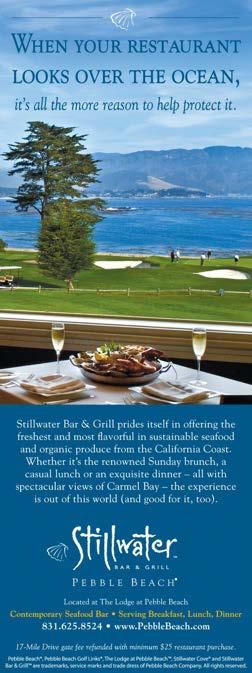
3 egg yolks
2 tablespoons unbleached white flour 1 teaspoon vanilla extract 5 egg whites ¼ teaspoon cream of tartar Salt Powdered sugar
Preheat oven to 325° F. Butter an 8-inch custard dish or 4 ramekins. Combine chocolate and butter in a large bowl over a pan of simmering hot water. Melt until butter and chocolate are evenly blended. Add stout and blend. Remove from heat. Whisk sugar into egg yolks and whisk egg yolk mixture into cooled chocolate mixture. Whisk in flour and vanilla.
Beat egg whites with cream of tartar and a pinch of salt until shiny, stiff peaks have formed. Be careful not to overbeat. Fold a dollop of egg whites into the chocolate mixture and gently blend. Add remaining egg whites and blend. Be careful not to overblend, as cake will deflate. Pour the batter into the custard dish or ramekins and place in a shallow baking dish. Add enough hot water to make a water bath that comes halfway up the custard dish or ramekins. Bake for 1½ hours. Cake will be done when skewer inserted in the center comes out with dry crumbs. Cool and lightly sift with powdered sugar.
www.ediblemontereybay.com 45

46 edible monterey bayfall 2012
Photo this page by Rob Fisher; opposite, by John Cox
Foodshed Pig Roast
A chef experiences where his pork comes from
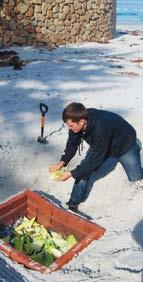 By John Cox
By John Cox
As I left Carmel-by-the-Sea and headed southeast, a strong ocean breeze was already pushing dark rain clouds overhead. But after a half-hour of driving deep into Carmel Valley, I managed to get far enough ahead of the storm to catch a glimpse of sun. Once I had turned off the road and had driven up a long gravel driveway, animals began to appear: first a handful of goats lounging beneath a stand of oaks, then a pack of barking dogs and finally, a pasture filled with an array of beautiful, happy-looking pigs.
As a chef, “calling in my meat order” is the politically correct way of saying that I just put pork cheeks on the menu and now it is time for someone to go kill 90 pigs so I can get three cases of hermetically sealed, ready-to-throw-in-the-pan nuggets of meat. I do this several times a week, sentencing thousands of cows, goats, pigs, chickens, bison, lambs, rabbits, deer, ducks and quail to the chopping block. Not once have I felt any moral dilemma or guilt.
But faced with the task of picking three pigs from a group standing a few yards away, I hesitated. There were sleek black-and-white Berkshires, striking red Tamworths, long, bristly snouted Russian wild boar, tender pink Yorkshires and a half-dozen different crossbreeds. They all looked so content, rooting in the dirt, leaning on their siblings and drinking from a motion-activated spigot of artesian spring water.
Eventually, I reluctantly pointed to a young wild boar reminiscent of the wild pigs I had seen strapped to hunting trucks when I had worked and lived on Maui. Next, I gestured towards two muscular Berkshires, and all three were corralled into a gated holding area.
I tossed an apple from my bag into the pen. The pigs rolled it around with their noses before taking a few timid bites and then inhaling it with enthusiasm. BANG! A pig jolted and then dropped to the ground. At this point some primal instinct took over. The bullet knocks the animal’s nervous system offline only briefly, and it’s the loss of blood that actually kills it. So for the animal’s sake, it’s important to move quickly. I stepped over the fence, grabbed the pig by the front leg and plunged an 8-inch chef’s knife through its jugular and into its heart, releasing a crimson torrent of warm blood. For a
moment there was calm, then the animal convulsed into a final death roll. As the pig lay in a pool of blood, its feet pointing toward the overcast sky, the adrenaline I had felt moments before was replaced with the macabre reality of our task. While I gathered my thoughts, Jaime and Amber—two of my accomplices—quickly dispatched the other two pigs in similar fashion.
We moved each pig onto a big, open-air work table and washed them thoroughly with a hose. Working on one pig at a time, we poured hot water from an iron tub over a section of hide, quickly scraping to remove patches of hair. If the water had been too hot, the skin would have contracted and hairs would have been scalded into place, too cool and the knife would have simply cut through sections of hair, leaving thick roots behind.
Next it was time for the gutting. This process requires a steady hand and good technique. The idea is to first barely score the belly and then create a pocket with two fingers that will enable you to slide the tip of your knife along the scored skin to open the chest cavity. After my knife picked up speed, it snagged on the intestines, and the smell sent away the small group of people who had huddled around the steel table. Once I had removed all of the animal’s entrails, flushed the cavity with water and checked carefully to make sure nothing was left behind, I was done.
I stepped back. All of a sudden there was an odd sense of comfort and familiarity. While this was far from the perfectly clean carcasses I was used to seeing delivered to my restaurants, there was no doubt this animal, whose eyes that I had looked into just half an hour before, had crossed the line from pig to pork. It was a revelation—the missing link in a food chain that so many of us blindly take for granted.
When I got my pigs home, I washed them again—this time with a mild food-grade sanitizer and then rinsed them with cold water. I put the two Berkshires away for later and rubbed the wild boar with olive oil, salt, brown sugar and chili powder and put it in the refrigerator for the night.
www.ediblemontereybay.com 47
When I lived in Hawaii, my friends and I would frequently roast pigs on the beach in an underground lava-lined pit called an imu. Banana stumps and ti leaves were used to insulate the meat, and the local red salt was traditionally the only seasoning.
My plan was to host a similar sort of roast on Carmel Beach, so at 7:00 the next morning, a friend and I started digging a pit in the white sand of a wind-sheltered cove below 13th Street. Once the pit was approximately 4-feet long, 3-feet wide and 3feet deep, we flattened the bottom and laid down a layer of foil, then lined the walls with red clay bricks.
While we were digging, we lit a fire on the sand, and after two hours, transferred the burnt logs and embers into our newly built underground oven. We piled a halfdozen large river stones and more firewood on top of the live coals, and a new fire came to life.
Next, we prepared our feast for the fire. We laid a clean, blue plastic tarp onto the sand and placed a layer of chicken wire on top. We put the pig on its back in the middle of the wire mesh and arranged foil-wrapped sweet potatoes, pineapples and kabocha squash around it. We lifted several of the hot river rocks from the fire and, to speed up the cooking of the pig, slipped some of them into its belly. As soon as the stones touched the pig’s flesh, an aromatic cloud of smoke—the scent of the meal to come— surrounded us.
At last ready to begin cooking the pig, we clamped the mesh around the pig and vegetables, covered the embers with fava bean stalks and leaves and carefully lowered it into the pit. We placed hot river rocks in the empty spaces between the mesh and the brick walls, covered it with another layer of fava bean leaves and topped it all with a thick woolen mat, a blue tarp and a layer of sand.
All was going well; the rain and fog had stayed away, and the sun brought out some of the Pacific’s most beautiful shades of turquoise.
But in the first setback of the day, I realized after pushing my meat thermometer through the layers of tarp and wool that its sensor had cracked, leaving me completely blind to the temperature inside the pit. After a few minutes, I pushed my hand through the sand and could feel heat coming up through the tarp.
I had done the best I could to replicate the cooking method I had learned on Maui, but with so many new variables, I had no idea whether the pig would come out a charred black lump of coal or a tepid mound of raw meat.
By 4pm, with drinks and side dishes in hand, a handful of friends and co-workers had started to gather on the sand, and the celebratory atmosphere of a pig roast had taken hold. The actual pig and its pit were so indiscernible, however, that my first guest actually walked halfway across it before I stopped her mid-step and guided her carefully back before the pit collapsed. Fifteen minutes later we brushed the sand from the tarp and carefully rolled it back. The layer of gray wool was steaming, and as I lifted it, I could see wilted fava leaves and crisp golden skin and caught a waft of roasted pork fat.
Feeling more confident, I poked the now worthless thermometer into the shoulder, waited a few seconds, removed it and placed the tip to my upper lip. Disaster! The metal was barely warm; the pork was still raw around the joints. I had underestimated how many hot stones I would need to heat a pit in Carmel’s cool sands, and the bricks had not done an adequate job of retaining the heat from the coals.
This was my worst nightmare. I feared I was about to disappoint a large group of my friends, but worse than that, I was scared that I had wasted the life of the pig. This was not just another piece of meat; it was an animal with intelligence and personality—an animal I had a huge personal investment in, both physically and psychologically.
We pulled the partially cooked pig from the dying coals and unwrapped it over the tarp. I removed the head, legs and loins and my friends fashioned a makeshift grill using a few pieces of wood from our nearby fire and the chicken-wire wrap as a crude grate. While we waited for the meat to finish cooking, we snacked on the roasted kabocha squash and pineapple. Both of these were sweet and juicy with a subtle smokiness from roasting in the wood coals. The meat browned quickly over the open flame, and soon we were enjoying pieces of roasted wild boar displayed unceremoniously on a buffet line of folding beach chairs. The pieces I tried

48 edible monterey bayfall 2012
There was no doubt this animal, whose eyes that I had looked into just half an hour before, had crossed the line from pig to pork.
This was my worst nightmare. I feared I was about to disappoint a large group of my friends, but worse than that, I was scared that I had wasted the life of the pig.
Photo by John Cox
Rub for roasting one pig
4 cups brown sugar 3 cups sea salt
1 cup guajillo chile powder
1 cup Meyer lemon zest 2 tablespoons ground wild fennel seed
1 cup Meyer lemon Agrumato oil
Linda’s Tasty Pork
Finding a local source for naturally raised pigs is not easy as there aren’t many local ranches that offer them. The ranch that I’ve come to rely on for consistent high quality is Linda’s Tasty Pork.

Linda is a ninth-generation rancher in Carmel Valley. She has been raising pigs since the age of seven and is a graduate of California Polytechnic University with a degree in animal science. The 2,000-acre ranch where she works and lives has been in her family since 1878. Today, Linda specializes in Berkshire and other heritage breeds.
Linda’s pork is sometimes available through the Mariquita Farm CSA program; you can also contact her directly and she can help you pick out a pig and have it butchered and packaged to your specifications at a local butcher shop. If you have lots of hungry friends, or room in a chest freezer, this is an incredible way to get naturally raised local pork at a reasonable price.
lindastastypork@gmail.com

www.ediblemontereybay.com 49
Courtesy John Cox, executive chef at Sierra Mar in Big Sur
Photo by Rob Fisher
were tasty, but I wondered whether it justified taking the pig’s life. But then again, why was this pig so special? Shouldn’t I treat every piece of meat with this kind of reverence?
Respect for ingredients should be every cook’s credo, but the farther people move from the origins of their food, the more difficult it becomes to remember the social and ethical impact of our everyday dining decisions. It’s easy to forget that when you purchase two pork tenderloins inside a neatly wrapped Styrofoam tray at the local supermarket, or choose an artfully presented entrée at a neighborhood bistro, you are supporting an entire system. Free range, natural, holistic, local, small farm—ultimately, many of the terms most of us rely on to make buying decisions have become mere marketing slogans. While the term “organic” requires certification, the rest are sometimes used on a whim to the benefit of both international food corporations and small local businesses.
At this point I should say that any meat that is going to be sold needs to be processed at a USDA-approved slaughter facility, but consumers who plan on using the meat only for personal consumption, as we did on Carmel Beach, have more options available. Animals do not benefit from being moved long distances or being placed in unfamiliar situations. From a quality standpoint, the best meat comes from the most relaxed animals. While government oversight of animal processing and food safety in general may operate with good intentions, it is deeply flawed and inadequate. I would strongly encourage anyone to perform their own due diligence and decide for themselves what is best for both their livestock and their family.
When I look back, there was nothing enjoyable about killing the pig, but if given the chance, I would do it again. The actual act of killing the animal was only a fraction of the entire experience. I witnessed where the pigs lived, what they ate, the other pigs they spent time with and many other aspects of their existence. These are things that can’t be taken for granted. At the end of the day, whether figuratively or literally, the blood is on your hands regardless of where you get your meat. Participating in the process is the only way to understand what you are supporting.
John Cox is the executive chef at Post Ranch Inn’s Sierra Mar in Big Sur. He cooked his way across the country from Montpelier, Vermont, where he graduated from the New England Culinary Institute, via Hana, Hawaii, where was corporate executive chef for Passport Resorts and most recently was executive chef at Casanova and La Bicyclette in Carmel.

RECIPE: For related story and a recipe, see p. 49.



50 edible monterey bayfall 2012
Why was this pig so special?
Shouldn’t I treat every piece of meat with this kind of reverence?



www.ediblemontereybay.com 51




52 edible monterey bayfall 2012
Roadside Diaries
Love Story
How one determined woman restored the historic Mesa Del Sol ranch, started a boutique winery and built a sustainable retreat center to honor her late husband
Written by Deborah Luhrman Photography by Geneva Liimatta
Jake Hougham was a self-made man. From humble beginnings in Salinas, he became an innovator in lettuce packaging. Like many hard workers, he dreamed of a gracious, relaxed lifestyle for his golden years— time spent sipping wine from his own vineyard, growing organic vegetables and raising chickens. But sadly that wasn’t meant to be. He died at age 54 of colon cancer, leaving his wife Ann to carry on. (Continued on p. 56)

www.ediblemontereybay.com 53

















54 edible monterey bayfall 2012

www.ediblemontereybay.com 55
(Continued from p. 53)
“I wanted to continue his dream because Jake was such a visionary,” says Ann. “While I was restoring the place, I definitely felt his presence. It was like I had a kindred spirit by my side, helping me make decisions. I knew what he would have said; I knew what he would have done.”
Guided by that vision, Ann Hougham has spent the past 12 years creating the Mesa Del Sol Estate Retreat and Winery on a 14acre parcel perched high above the Arroyo Seco River, halfway from Carmel to Greenfield, at the rugged and picturesque end of Carmel Valley Road.
At the time the Houghams bought the property in 1998, it was overgrown and rundown. But there was much to be discovered underneath the overgrowth.
“It was like entering a secret garden,” Ann says. “I didn’t even realize there was a swimming pool until we started pruning.”
Seven acres of syrah, sangiovese and zinfandel grapes went in the first year, but Jake didn’t live to see the first harvest. “When he died in October 2000, I had a time of grief and then got back to work.”
Ann spotted an iron clawfoot bathtub dumped over the cliff by previous owners, so she got a winch and hauled it back up the 150foot canyon. “We opened up the magnificent views, re-painted and re-did everything to make it work again,” she says.
She also got down on her hands and knees and expertly re-tiled the bathrooms, kitchen and the swimming pool herself—a craft she learned during her first marriage to a construction contractor with whom she designed and built custom homes in the Lake Tahoe area.
Ann is clearly a woman of many talents and great determination, evidenced also by her love for mountain climbing. She has hiked Mt. Hood, twice scaled snowy Mt. Shasta and recently climbed Mt. Whitney.
Mesa Del Sol has a colorful history. An old stone building and the stone foundation of one of the cabins date back to the 1800s and are believed to be part of a stagecoach stop for travelers on their way to Mission San Antonio. In the early 1900s, several cabins were built and the property was used as a health center. The hot, dry air was soothing for tuberculosis patients. President Teddy Roosevelt once relieved his asthma with a stay at the property.
State Senator Fred Weybret, a newspaper publisher from Salinas, purchased the property in 1927 and built the early California ranchstyle house. After his death in 1945, it passed to Salinas lettuce baron Steve Rianda and his wife Mary, who named the place Mesa del Sol, Spanish for “sunny plateau.”
But current owner Ann Hougham is the one who turned the property into a real Garden of Eden. In addition to grapes, there is an organic vegetable garden, fruit trees, laying hens and honeybees.
A trout pond in the middle of the property provides what she calls special “living water” used to irrigate the vineyards. The pond is filled with algae and microorganisms—nutrients that produce extra-healthy vines.
Only 350 cases of wine are produced a year under the Mesa Del Sol label. The rest of the grapes are sold to local winemakers, including Nicholson Vineyards in Aptos and Pelerin Wines in Carmel Valley. The quality is excellent. A 2002 Syrah produced with her grapes by Hunter Hill Winery in Soquel won “Best of Show” at the California State Fair, beating out 2,800 other wines. She proudly displays the gold ribbon in the living room.
Most Mesa Del Sol wine is made at nearby Wrath Wines. Coastview Vineyards’ Ian Brand is the winemaker in charge, elaborating syrah and sangiovese varietals, as well as a soon-to-be-released zinfandel and a blend called Prima Rosso. The syrah continues to impress the experts: Mesa Del Sol’s 2006 vintage just won a silver medal in Sunset magazine’s first wine competition. To try for yourself, you can taste and purchase them at Trio Carmel on Dolores Street between Ocean and 7th. They are also served at Mission Ranch in Carmel and Ristoranti Avanti in Santa Cruz.
For the past three years, Mesa Del Sol has operated as a retreat center. Small groups and extended families tend to take over the ranch’s seven bedrooms, which are spread out among a main house, cottages and a safari tent. The main house offers a full kitchen and a large, redwood-paneled living room with a stone fireplace. Decoration is country chic, with antiques Ann has gleaned from garage sales and the fair at Moss Landing.
A day at the ranch may be spent hiking, swimming, cooking or sitting in the hot tub. But it is the peacefulness and the chance to experience life on a sustainable working ranch that brings people back year after year.
Outdoors, the air is perfumed with the scent of lavender and wild fennel. You can spot red-tailed hawks and sometimes a golden eagle soaring over the canyon. When Ann Hougham stands by the cliff, she says she can feel the spirit of her husband. “I still miss him terribly, but I know he is pleased with what I’ve accomplished.”
Mesa Del Sol Estate Retreat & Winery 831.624.8527 • www.mesadelsolvineyards.com.
56 edible monterey bayfall 2012
At the time the Houghams bought the property in 1998, it was overgrown and rundown. But there was much to be discovered underneath the overgrowth.
“It was like entering a secret garden.”



www.ediblemontereybay.com 57



58 edible monterey bayfall 2012
The Preservationist Kombucha, Kvess and Kefir
Refreshing and nutritious fermented drinks—and how to make them at home
By Jordan Champagne
Margaux Gibbons
Autumn is a wonderful time to get into making fermented beverages like kombucha, the effervescent, fermented sweet tea that has swept much of the good food world. The exciting summer fruits and vegetables are winding down, and we settle into short days and want to spend more time in the kitchen. Here on the Central Coast, the weather also tends to be at its driest and sunniest, so it’s also a great time to create something that’s refreshing as well as healthful and delicious.
The kind of lightly fermented drinks we’re talking about here are loaded with probiotics that support our health—and the standard American diet is largely lacking in foods containing these probiotics. The drinks are also simple and can be made in very small batches and easily tailored to your own palate. You can use fruits and vegetables and spices to flavor your fermented drinks into endless combinations.
There are many great recipes and books out there, with Sandor Ellix Katz’s recently published The Art of Fermentation being the most complete and interesting. Sandor is my hero. In his book and by his nature, he empowers you with his library of knowledge and inspires you to get started in your own kitchen right away.
I recently interviewed Sandor when he was in the middle of a four-week fermentation workshop and he had all sorts of unique fermented beverages going, including bread kvass and plum-flavored, water kefir.

When I asked him why kombucha—the most in-demand fermented beverage of our time—is so wildly popular, he said, “It is through the grassroots mechanisms of the ‘mother’ (kombucha’s ever-growing starter) needing a home. It has a built-in pyramid
scheme to it. When the mother reproduces, people are trying to sell their friends on it to share their mother…it is the power of mass marketing.”
It is no coincidence that fermented foods are “cultured” foods and that culture is something that we look to share with friends and hand down generation to generation.
“When fermenting food, we are taking traditional ideas and recombining them in ways to keep them current. This is how we keep these cultural legacies relevant—we recombine them and make them our own,” Sandor says.
This is so brilliant to me and really exemplifies how we morph old traditions into our modern kitchens and why that feels so good. These fermented drinks give us a chance to connect with traditions all over the world in simple ways and to nourish ourselves in a delicious way.
While kombucha is tasty, supportive of good health and a great choice for your first beverage-fermenting project, Sandor points out that there is a great, wide world of fermented beverages out there and he argues we should not neglect them just because kombucha happens to be such a favorite.
Sandor has fun with fermented beverages and shows you that you can get really creative. He jumps around from kefir (traditionally a fermented milk drink) to kvass (traditionally made from rye flower or bread) and noni (a fermented fruit drink) as if they are common knowledge, and emphasizes that each can be altered and adorned by what is available seasonally.
There are many possible ways to get the fermentation process started, including cultures and yeasts, Sandor points out. There are
www.ediblemontereybay.com 59
Photo by
even organisms found on all fruit to initiate fermentation. In his book, he speaks of “rasp bubble,” a creation by a woman using raspberries, water and honey where the organisms on the raspberries are what starts the fermentation process. It can be that easy!
At the end of our conversation, Sandor and I started to celebrate how food brings people together and builds community. Every step of the way is a chance to develop relationships in growing or procuring your food, working with it in your kitchen and sharing it with others.
“Food is where people come together and if we look at it, it is where the microorganisms themselves also exist in communities,” Sandor says. There is not a single isolated organism in the complex communities and dynamic structures, and they even have defense strategies. Communities are reflected in these foods on a lot of levels.
Jordan Champagne is the co-owner and founder of Happy Girl Kitchen Co. She has a passion for preserving the local, organic harvest and loves sharing her secrets at the workshops she teaches across the region. And if you have trouble with your kombucha, she’ll serve you her own at Happy Girl’s cafe in Pacific Grove, where kombucha is always on tap.
Happy Girl Kitchen Co. • 173 Central Ave., Pacific Grove 831.373.4475 • www.happygirlkitchen.com
Fruit Kvass
Adapted from a recipe by Hannah Springer in The Art of Fermention, by Sandor Ellix Katz. Used with permission from the author.
Pick out a combination of fruit, berries and fresh herbs or spices that you think would go well together, and get started. Be sure to use organic ingredients for best fermentation.
In a 1 quart/liter wide-mouth mason jar, combine the following:
A big handful of berries 1 sliced “core” fruit (such as apple or pear) 1 tablespoon grated ginger 1/2 cup/125 ml raw milk whey Enough filtered water to fill the jar
Combine all ingredients, top off with water and place a weight of some sort on top of the fruit to keep it submerged and close tightly. Leave on a counter in a warmish place for three days, and then transfer to the fridge. When the liquid gets low, you can top off the jar with filtered water and a splash of whey until all the fruit has been fermented. This recipe can be varied by using different fruits, citrus juices, fresh herbs or even vegetables.
Springer’s blog can be found at www.healthyfamilychronicles.blogspot.com.
Kombucha Tea
Courtesy Jordan Champagne, Happy Girl Kitchen Co.
Yields 1 quart
Many folks have had an experience with this mysterious beverage. It’s slightly fizzy and tangy, so unique and alive tasting that you know it must be good for you! Thought to have originated in China, this elixir of health has traveled the world since then, taking root in Russia alongside kvass and finally starting a craze here in America in the mid-1990s. Kombucha is sweetened black tea that is then cultured with a “mother,” or starter, fermenting into a sour, living tonic. The mother is a symbiotic colony of yeasts and beneficial bacteria that reproduce themselves while each batch is made, giving rise to a new gelatinous mass and the production of organic acids, enzymes, probiotics, antioxidants and polyphenols. “These nutrients help harmonize and revitalize each individual’s unique condition for optimal health,” explains my friend Adam, who produces thousands of gallons in Santa Cruz through his company, Kombucha Botanica.
1 quart pure water ¼ cup sugar
1 tablespoon loose black tea (or two tea bags)
½ cup kombucha mother (kombucha starter)
Bring water and sugar to a boil, mixing thoroughly in a cooking pot. Turn off heat, add the tea and steep approximately 15 minutes. Strain the tea and let cool to body temperature. Transfer to your fermentation vessel. Glass seems an ideal container, so you can enjoy the mysterious SCOBY (symbiotic community of bacteria and yeasts). Using a container that has a wide top compared to depth allows a larger culture to grow on the surface. Having a bottom spout allows you to easily drain off tea.
Add the kombucha mother, with the opaque, firm side up, along with the liquid it is stored in. Cover with a cloth and let mature in warm location, around 70–85° F. Taste the liquid after a few days to 1 week, depending on temperature. A skin will develop on the surface—the new mother is taking shape. The tonic becomes more acidic the longer it ages. When it develops the sourness you prefer, it is finished. Take out the mother and store in a jar with a bit of liquid (up to a couple months) until you’re ready to make another batch.
Store the finished kombucha tea in the fridge; you may leave it there for a month or so. Flavor it to add depth or sweetness as you like—ginger juice to add zing, pomegranate juice, maple syrup, orange juice or others.
60 edible monterey bayfall 2012

www.ediblemontereybay.com 61
Edible Events
Costanoa Lodge, Earthbound Farm and The Restaurant at Ventana
Food adventures in Big Sur, Pescadero and Carmel Valley
By Camilla Mann and Sarah Wood
This past spring and early summer, Edible Monterey Bay joined forces with three off-the-beaten-path culinary gems to host pop-up meals that included such adventures as an informative hike, an intriguing farm tour and a chance to camp at an ecoadventure resort. Each gathered locavores from around the region in beautiful settings, but the meals themselves stole the show.
The Restaurant at Ventana, Ventana Inn and Spa, Big Sur
Guided hike and pop-up brunch, May 26 Edible Monterey Bay’s May pop-up brought me to the Ventana Inn and Spa for a hike and a brunch. Gathering in front of The Restaurant at Ventana, our group of culinary adventurers chatted amicably before heading out with Stephen Copeland, a long-time Big Sur resident and owner of Big Sur Guides. Part naturalist and part local historian, Copeland regaled us with stories of Hatfield and McCoy-style feuds between Big Sur landowners and reminisced about Lolly Fassett, who started the Nepenthe Restaurant after nurturing the local community nightly with her roasted chicken and stuffing.
As we wound our way alongthe trails, Copelanddiscussed howyounger redwoodtrees create tightrings around theirparents. Heexplained how theNative Americansviewed the redwoodrings as sacred circles of life. At onepoint, our group stood in the center of one of these circles. Surrounded by 16 giants, we inhaled the citrusy scent from the duff beneath our shoes, listening to the energetic chirps of the wood sparrows.
With stomachs rumbling, we were guided back to The Restaurant at Ventana under an arbor embraced by gnarled vines and the heady fragrance of honeysuckle.
First task: to select one of Ventana’s unique libations. There was the de rigueur Bellini and ubiquitous Mimosa, but it was the more innovative offerings that intrigued me. I vacillated between the St. Germain Royal-Roederer Brut with St. Germain el-

62 edible monterey bayfall 2012
Photo by Camilla M. Mann
Happy hikers: enjoying the terrace at the Restaurant at Ventana.
derflower liqueur, and a lime wheel—and the Hair of the Dog Punsch, a lemon-infused Zaya rum with spiced black tea.
I opted for the punsch—whose seemingly errant “s” is not actually a typo—the name of the Nordic drink that inspired the cocktail. Though I was initially reluctant to order it because rum cocktails are notoriously syrupy, the name was irresistible. The concoction was spicy, slightly bitter and served hot—a vivid contrast to the chilled, effervescent St. Germain that I sampled by sneaking a sip from my friend’s champagne flute.
Clinking our glasses amid celebratory toasts, we considered the entrée offerings. Chef Truman Jones had fashioned a generous menu with everything from chicken enchiladas to a classic Caesar salad and homemade granola to a Big Sur burger.
Eggs Benedict is my favorite, so the choice was simple. Toasted English muffins were topped with steamed spinach and pillows of perfectly poached eggs. The applewood-smoked pork loin was crispy enough to lend texture to the mouthfeel, yet soft enough to complement the silky eggs. And I was grateful that the Hollandaise sauce added lemony flavor without drowning the dish.
While I didn’t taste any of the other entrées, the empty plates that lined our table by the meal’s end were a good sign that the other choices were delectable, too.
Table chatter ran the gamut from local food events to recipes and culinary processes. We imagined how we could use the sprigs of California sage that Copeland had plucked for us. I’m considering a roasted chicken with stuffing in Lolly Fassett’s honor: leeks, celery, rye bread, California sage and lots of butter. —CM
Cascade Bar and Grill, Costanoa Lodge, Pescadero Pop-up Supper Club and Camping Trip, June 2

I’d never been to Costanoa Lodge until Edible Monterey Bay’s pop-up there in June, but even before I’d arrived, it was easy to vow I’d return. Costanoa is a 25-minute drive up Route 1 from Santa Cruz’s Westside, and just getting there offers jaw-dropping views of small coastal farms, plunging cliffs and beautiful beaches.
By the time I passed the sign for Año Nuevo State Park and turned onto Costanoa’s eucalyptus-scented access road, the stresses of my day were in perspective, and I was ready to take in the natural beauty of this ecoadventure resort.
My destination was Costanoa’s elegant yet rustic Cascade Bar and Grill. Our guests soon arrived from as far as San Jose to the north and Monterey and Carmel Valley to the south, and we got to know one another over a glass of sparkling wine from Bonny Doon Vineyard, which provided generous pairings for each of the meal’s five courses.
When it was time for dinner, we were offered either a tangy-sweet, vegetarian Peruvian quinoa that was filled with Costanoa’s own vegetables, or a fillet of tenderloin.
Hunter Brawley, who has since taken over as the restaurant’s chef, has left the delicious vegetarian quinoa on the menu, and has also replaced the fillet and other heavier dishes with lighter, more seasonal fare, including much more fish. The restaurant is also incorporating into its meals as much

www.ediblemontereybay.com 63
Photo by Ted Holladay
Costanoa Cascade Bar & Grill Chef Hunter Brawley.
Monterey Bay marketplace

local, organic and sustainable ingredients as the restaurant can grow in its own biodynamic garden and procure from local fishermen, farmers and food artisans. (Harley Farms, which provided the chèvre for our salad and Swanton Berry Farm, which supplied the strawberries for our shortcake, are located just up and down the road, respectively.)
The menu spans both fine dining and comfort food, and the new seafood entrées, which I tried on a later visit, included a rich cioppino as well as succulent halibut and scallops. The menu also included a number of local, biodynamic and sustainable wines.
“When you come here, you’re actually going to get a taste of here,” says Brawley, who trained in both classic French-Southern cuisine and cooking with fresh, local ingredients under Linton Hopkins and other highly regarded Atlanta chefs, adding that the restaurant is attracting more diners from around the region, who are just coming in for dinner, rather than to stay over. “I want people to be able to come away and have a Big Sur type of experience—get away, enjoy nature and also have a great dining experience.”
The night of our pop-up, most of our guests took advantage of the chance to stay over in one of Costanoa’s tent bungalows.
When we gathered for dinner, we swapped ideas for exploring the area. One family had already been to Harley Farms, where they’d introduced their preschooler to alpine goats and the huge array of artisanal cheeses that the dairy puts out for its visitors to taste. A couple of moms had just arrived without their kids to celebrate the start of summer, and they were looking forward to hiking.
By the evening’s end, I was sad that I couldn’t stay over myself, but as I enjoyed the stunning views on the drive home, I began to plan my return. —SW
RECIPE: See “Recipes” tab on the Edible Monterey Bay home page for Brawley’s cioppino, pictured on our cover.
Earthbound Farm’s Farm Stand, Carmel Valley
Pop-up farm-to-table dinner and farm tour, celebrating the Farm Stand’s 20th Anniversary, July 14
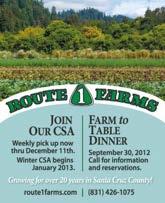
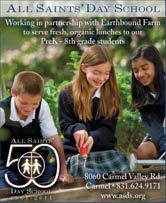
“Farm Stand” is really much too modest a term for Earthbound Farm’s beautiful and multi-faceted Carmel Valley location. In fact, just as Earthbound has over the last 28 years become the country’s largest organic grower, helping provide much-needed access to fresh, organic food across the U.S., so too has the Farm Stand grown over the last two decades into a beloved Carmel area institution, offering both a reliable source of fresh, organic food and a connection to where that food comes from.
Over time, the Farm Stand has expanded to become an event center that, with its demonstration farm and its gardens and organic kitchen, provides everything from bug walks to cooking classes, as well as an organic grocery, garden center and organic café.
What’s more, for the pop-up dinner that Earthbound founders Myra and Drew Goodman and Edible Monterey Bay hosted in July to honor the 20th anniversary of the location, Earthbound opened its new gardenside, open-walled event space for a public dinner event for the first time.
The evening benefited Ag Against Hunger, the Spreckels-based organization that has helped feed millions of hungry people by collecting surplus produce from Monterey Bay area growers and delivering it to local food banks.
Fittingly, the evening began with a farm tour. Taking along our delicious glasses of wine—a Chenin Blanc donated by Heller Estate Organic Vineyards and a Chardonnay from Bernardus Winery—we followed behind Janna Jo Williams, the Farm Stand’s enthusiastic resident farmer and event organizer.
Along the way, we savored tiny glasses of chilled curried carrot and coconut soup and learned about such things as how to grow a real corn maze, what companion planting is and how fresh lemon verbena leaves can be used for an impromptu natural perfume.
But the highlight of the evening was the all-organic dinner. Sarah LaCasse, executive
64 edible monterey bayfall 2012
chef of the farm stand’s 10-year-old organic kitchen, went all out.
The six savory courses included fennelrubbed pork tenderloin with succulent grilled figs and a rosemary, garlic and lemon roast chicken served with farro and smoked tomato–basil butter. Four bright, inventive and hearty salads were enough to make any vegetarian foodie swoon. A wild rice and raspberry salad and a twist on a classic salade Nicoise were both delicious surprises.
Earthbound began as a 2.5-acre Carmel Valley raspberry farm, so it was appropriate that after dinner, we headed into the Farm Stand’s raspberry patch to pick fresh raspberries for miniature strawberry-raspberry shortcakes—one of four different berry desserts that provided the celebration’s finale.
What each course had in common was a reminder of how much better food is when it is made with nutrient-rich, fresh, organic ingredients.

Before the night was over, the Goodmans spoke about the history of both Earthbound and its Farm Stand, recounting that they started the Farm Stand two decades ago to maintain a connection to the Carmel Valley community after Earthbound relocated its head offices to Watsonville and later, San Juan Bautista.

“Twenty years ago, we never would have dreamed that Earthbound Farm or organic food would have achieved the popularity that exists today,” Drew Goodman said. We’re glad they have. —SW
For details on EMB’s fall pop-ups at Stone Creek Kitchen of Monterey, Laílí’s in Santa Cruz and La Crema in Pacific Grove, see p. 75 and follow our RSS, Facebook and Twitter feeds. Bon appétit!
www.ediblemontereybay.com 65
Guests at Earth Bound Farm’s Farm Stand.
Photo by Rob Fisher
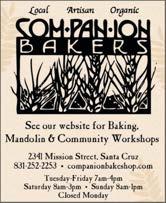


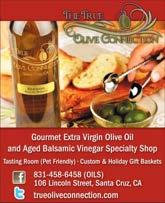





66 edible monterey bayfall 2012
•
marketplace
Monterey Bay
marketplace
Monterey Bay

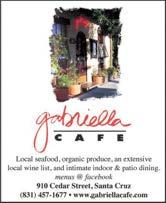


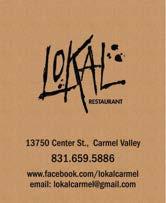


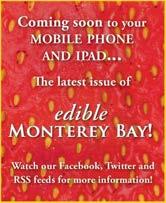
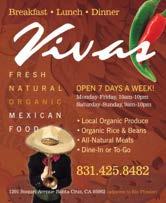
www.ediblemontereybay.com 67
Monterey Bay marketplace
•
Monterey Bay marketplace

68 edible monterey bayfall 2012
MONTEREY BAY FALL FARMERS’ MARKETS
MONTEREY COUNTY
CARMEL
Carmel Certified Farmers’ Market at The Barnyard 3690 The Barnyard 831.728.5060
Tuesdays, 9am–1pm • Open May–September cbarr@montereybayfarmers.org www.montereybayfarmers.org WIC
CASTROVILLE
North County Farmers’ Market 11261 Crane St. North County Recreation Center 831.633.3084
Thursdays, 4pm–dusk • Open April–October www.ncrpd.org
GONZALES
Central Park Gonzales Fifth Street 831.905.1407
Fridays, 3–7pm • Open March–November EBT/WIC
KING CITY
King City Farmers’ Market
Broadway Street between First and Second streets 831.385.3814
Wednesdays, 4–7pm • Open May–October www.kingcitychamber.com EBT/WIC
MARINA
Marina Certified Farmers’ Market 215 Reservation Rd.
Marina Village Shopping Center 831.384.6961
Sundays, 10am–2pm www.everyonesharvest.org EBT/WIC
MONTEREY
Del Monte Certified Farmers’ Market
Del Monte Shopping Center 1410 Del Monte Center Whole Foods parking lot 831.728.5060
Sundays, 8am–12pm • Open May–October cbarr@montereybayfarmers.org www.montereybayfarmers.org WIC
Monterey Fairgrounds
Certified Farmers’ Market 2004 Fairgrounds Road, Gate 8 831.235.1856
Mondays, 9am–4pm • Open year-round
Monterey Certified Farmers’ Market
Monterey Peninsula College 980 Fremont Street, parking lot 831.728.5060
Fridays, 10am–2pm Open year-round, rain or shine cbarr@montereybayfarmers.org www.montereybayfarmers.org WIC


Old Monterey Market Place
Alvarado Street between Del Monte and Pearl 831.655.2607
Tuesdays, 4–7pm (winter), 4–8pm (summer) Open year-round, rain or shine www.oldmonterey.org
PACIFIC GROVE
Pacific Grove Certified Farmers’ Market
Central and Grand avenues, in front of Jewell Park 831.384.6961
Mondays, 4–7pm • Open year-round www.everyonesharvest.org EBT/WIC
SALINAS
Alisal Certified Farmers’ Market
632 E. Alisal St., Gabby Plaza 831.384.6961
Tuesdays, 11am–4pm • Open spring–November www.everyonesharvest.org EBT/WIC
Closter Park 401 Towt St. 831.905.1407
Saturdays, 8am–2pm • Open year-round EBT/MIC
Natividad Medical Center Farmers’ Market 1441 Constitution Blvd. 831.384.6961 Wednesdays, 11am–3:30pm Open May–November www.everyonesharvest.org EBT/WIC
Salinas Old Town Marketplace
Alisal and Main streets behind Rabobank 831.905.1407
Saturday, 9am–2pm • Open year-round www.oldtownsalinas.com/market.asp EBT/WIC
SAND CITY
The Independent Marketplace 600 Ortiz Ave. 831.394.6000
First Thursday of every month, 4–9pm Open year-round www.sandcityca.com
SOLEDAD
Soledad Farmers’ Market
Front and Encinal streets 831.402.6616
Thursdays, 4–8pm • Open May–October oldtownsoledad@yahoo.com EBT/WIC
www.ediblemontereybay.com 69
Photo at Earthbound Farm by Rob Fisher
SAN BENITO COUNTY
HOLLISTER
Hollister Certified Farmers’ Market
Fifth and San Benito streets 831.636.8406
Wednesdays, 3–7pm • Open May–September www.downtownhollister.org
EBT/WIC
SANTA CRUZ COUNTY
APTOS
Aptos Certified Farmers’ Market
Cabrillo College, 6500 Soquel Drive
Cabrillo College, parking structure 831.728.5060 • Saturdays, 8am–12pm
Open year-round, rain or shine cbarr@montereybayfarmers.org www.montereybayfarmers.org
EBT/WIC
Seascape Village
Certified Farmers’ Market
Seascape Village • 831.685.3134 Sundays, 11am–2pm • Open May–October
CAPITOLA
Capitola Mall Farmers’ Market 1855 41st Ave., parking lot 831.465.0773 Thursdays 3:30–7pm • Open April–November
FELTON
Felton Farmers’ Market 120 Russell Ave. at Hwy. 9 St. John’s Catholic Church 831.454.0566 • Tuesdays, 2:30–6:30pm Open May–October, rain or shine www.santacruzfarmersmarket.org
EBT/WIC
SANTA CRUZ
Downtown Santa Cruz Farmers’ Market
Lincoln and Cedar streets 831.454.0566
Wednesdays, 1:30–5:30pm (winter) Open year-round, rain or shine www.santacruzfarmersmarket.org
EBT/WIC
Live Oak/Eastside Farmers’ Market
21511 E. Cliff Drive
East Cliff Shopping Center 831.454.0566 • Sundays, 9am–1pm Open year-round, rain or shine www.santacruzfarmersmarket.org
EBT/WIC
UCSC Farm & Garden’s Market Cart 1156 High St. at Bay Street 831.459.3240
Tuesdays and Fridays, 12–6pm Open June–October www.casfs.ucsc.edu EBT
Westside Santa Cruz Market 2801 Mission St. at Western Drive 831.454.0566 • Saturdays, 9am–1pm Open year-round, rain or shine www.santacruzfarmersmarket.org EBT/WIC
SCOTTS VALLEY
Scotts Valley Farmers’ Market
360 Kings Village Rd. Scotts Valley Community Center 831.454.0566 • Saturdays, 9am–1pm Open year-round, rain or shine www.santacruzfarmersmarket.org EBT
WATSONVILLE
Watsonville Certified Farmers’ Market Peck and Main streets 831.234.9511
Fridays, 3–7pm, Sundays, 1–5pm Open year-round, rain or shine EBT/WIC
Watsonville Fairgrounds
Certified Farmers’ Market 500 Harkins Slough Road Pajaro Valley High School 831.235.1856
Saturdays and Sundays, 9am–4pm Open year-round
NEARBY COMMUNITIES
HALF MOON BAY
Certified Coastside Farmers’ Markets— Shoreline Station 225 Cabrillo Highway S. 650.726.4895 • Saturdays, 9am–1pm Open May–December farmersmarket@coastside.net www.coastsidefarmersmarket.org
MORGAN HILL
Morgan Hill Farmer’s Market
Third Street Promenade and Depot Street 800.806.3276
Saturdays, 9am–1pm • Open May–December cafarmersmkts@gmail.com www.cafarmersmkts.com
PACIFICA
Certified Coastside Farmers’ Markets— Rockaway Beach
200 Rockaway Beach Ave. 650.726.4895 Wednesdays, 2:30–6:30pm Open May–December farmersmarket@coastside.net www.coastsidefarmersmarket.org
PESCADERO
Pescadero Grown! Farmers’ Market 251 Stage Road 650.879.1691
Thursdays, 3–7pm • Open May–October outreach@mypuente.org www.pescaderogrown.org
LA HONDA
La Honda Farmers’ Market
8875 La Honda Road (between Fire Station and Puente Offices) 650.879.1691
Tuesdays, 3–7pm • Open May–October outreach@mypuente.org www.pescaderogrown.org
FARMERS’ MARKETS DAYS OF WEEK
Sunday: Aptos, Marina, Monterey, Santa Cruz, Watsonville
Monday: Monterey, Pacific Grove
Tuesday: Carmel, Felton, La Honda, Monterey, Salinas, Santa Cruz
Wednesday: Hollister, King City, Pacifica, Salinas, Santa Cruz
Thursday: Capitola, Castroville, Pescadero, Sand City, Soledad
Friday: Gonzales, Monterey, Santa Cruz, Watsonville
Saturday: Aptos, Half Moon Bay, Morgan Hill, Salinas, Santa Cruz, Scotts Valley, Watsonville
70 edible monterey bayfall 2012
APTOS

Dine Local Guide

Carried Away
7564 Soquel Drive • 831.685.3926
www.carriedawayfoods.com
A cozy, green-certified take-out or eat-in café, Carried Away has a menu that changes weekly and features primarily organic, locally sourced ingredients. Owner-chef Tom McNary worked for many years at Chez Panisse and his dishes reflect the seasons. Soups, salads, entrees and desserts are all made fresh daily. Thin-crust pizzas available on Tuesday, Friday and Saturday. Open M–F 11am–7pm, Sa 11am–5pm, closed Su.
BIG SUR
The Restaurant at Ventana 48123 Highway 1 • 831.667.4242 • www.ventanainn.com
A peaceful fireplace setting and rustic wood interior give way to a legendary terrace with some of the most amazing views Big Sur has to offer. Chef Truman Jones’ cuisine uses fresh, seasonal and sustainable ingredients sourced from local farms and foragers and reflects his memories of growing up on a farm and his experience working in some of the world’s most-acclaimed restaurants. The menu changes frequently; the wine list is award-winning. The Ventana Bistro is available for private events. Open daily for breakfast 7:30 to 10:30, lunch 11:30am–4:30pm, dinner 6–9pm.
BOULDER CREEK
New Leaf Community Market
13159 Highway 9 • 831.338.7211 • www.newleaf.com
New Leaf offers some of the best fresh food made and grown here on the Central Coast. Made-to-order sandwiches, salads and hot foods are all natural. No nitrates, hormones, antibiotics or artificial ingredients. The Coastal Kale Salad is a big favorite; wide selection of picnic supplies to be found here, too. Open 9am–9pm every day.
CAPITOLA
New Leaf Community Market
1210 41st Avenue • 831.479.7987 • www.newleaf.com
See description under Boulder Creek. Open 8am–9pm every day.
Whole Foods Market

1710 41st Avenue • 831.464.2900 www.wholefoodsmarket.com
Too busy to cook? Looking for a healthy eat-in café or source of picnic supplies? Head for the prepared foods section of Whole Foods Market, where everything is natural or organic and as much as possible is locally grown. There are ethnic specialties, salads, soups, fresh pizza and a coffee bar. Open 8am–9pm every day.
CARMEL
California Market at Hyatt Carmel Highlands 120 Highlands Drive, Carmel 831.622.5450 • www.highlandsinn.hyatt.com


Locals and visitors alike enjoy the rustic elegance of this casual bistro. Whether dining al fresco overlooking magnificent Yankee Point or indoors by the pot-bellied stove, the California Market menu offers an eclectic array of offerings. At breakfast, look for frittatas, omelets, breakfast panini, sticky bun French toast; lunch includes fresh seafood, pastas, sandwiches and daily specials. Service begins at 7am.
Carmel Belle

Doud Craft Studios • Corner of Ocean and San Carlos • 831.624.1600 • www.carmelbelle.com

Passionate about sourcing the best local ingredients and meticulous about identifying them on the menu, Carmel Belle is a delicious choice for breakfast or lunch. Almost everything is organic, from the coffee to the meats and cheeses. Faves include a warm slow-cooked Berkshire pork sandwich with red onion-currant chutney on ciabatta, and their house-made mozzarella and asparagus panini. Open daily 8am–5pm.
Carmel Valley Coffee Roasting Co.
The Barnyard Shopping Village, 3720 The Barnyard, Carmel • 831.620.0844 • www.carmelcoffeeroasters.com
Open M-F 6am–6pm, Sa 7am–5pm, Sun 7am–4pm
The only certified-organic coffee roasting company on the Monterey Peninsula, Carmel Valley Roasting Co. operates six coffeehouses and provides beans and coffee to area restaurants, hotels and markets. Owners Dean and Janet McAthie’s mission is to create superior, handcrafted coffee by roasting the finest Arabica beans in the company’s new Italian Farina coffee roaster. Each of their coffeehouses offers a unique experience, providing light fare such as bagels, pastries and sandwiches.
Carmel Valley Coffee Roasting Co.


Crossroads Shopping Village, 246 Crossroads Blvd., Carmel 831.626.8784 • www.carmelcoffeeroasters.com
Open M-F 6:30am–6pm, Sa-Su 7am–6pm
www.ediblemontereybay.com 71
All of these restaurants emphasize local ingredients, and they also advertise in Edible Monterey Bay! Stop by for a free issue, and thank them with your business!
Photo by Geneva Liimatta
Carmel Valley Coffee Roasting Co.
Mid Valley Shopping Center, 319 Mid Valley Center, Carmel • 831.622-0787 • www.carmelcoffeeroasters.com
Open M-F 6am–5pm, Sa-Su 6am–3pm See description under Carmel for The Barnyard location

Carmel Valley Coffee Roasting Co.


Ocean Avenue between Lincoln and Monte Verde, Carmel831.626.2913 • www.carmelcoffeeroasters.com
Open Su-Th 6am–6pm, F-Sa 6am–7pm
See description under Carmel for The Barnyard location
Earthbound Farm’s Farm Stand Organic Kitchen

7250 Carmel Valley Road • 831.625.6219 www.ebfarm.com/OurFarmStand
Organic is essential at Earthbound Farm. In addition to fresh organic produce, prepared foods and gourmet groceries, the farm stand has a colorful salad bar and a certified organic kitchen. Under the direction of Executive Chef Sarah LaCasse, the kitchen turns out homemade soups and bakery goods daily. Take out or eat on site at tables set in the garden. The Farm Stand also hosts cooking demonstrations and other classes and activities. Open M–Sa 8am–6:30pm, Su 9am–6pm.
Lokal 13750 Center St. • 831.659.5886 www.facebook.com/lokalcarmel
Despite the Carmel Valley Village location, Chef Brendan Jones has no difficulty attracting full houses nightly. The incredients for his exceptionally creative and sophisticated cuisine are sourced locally, and the inspiration, from Japan, Spain and other parts of Europe. Tuna x3, ceviche, roasted bone marrow and cabbage soup with mustard ice cream are not to be missed. Local wines and beer are poured at a 28foot reclaimed wood bar. All food is organic when possible. Open for dinner Thu–Sa 6:00 breakfast and lunch Tu–F 7–3 and Sa 9–2.
Marinus
Bernardus Lodge, 415 W. Carmel Valley Road 831.658.3595 • www.bernardus.com
Marinus has a new wine country-chic interior echoing the restaurant’s herb garden in its sage, lavender, burgundy and olive colors. It is a good fit for the stellar California cuisine of Chef Cal Stamenov, who loves searching out rare, highquality local ingredients—many of them now grown in the restaurant’s 6-acre organic garden or brought in by local foragers. Private parties can book dinner in the award-winning wine cellar or at the chef’s table in the kitchen, where Julia Child and dozens of celebrities have dined. Open for dinner W–Su 6–10pm.
Mundaka San Carlos between Ocean and Seventh • 831.624.7400 www.mundakacarmel.com
A convivial Spanish restaurant and tapas bar hidden away at the back of a Carmel courtyard, Mundaka is named for a coastal town in the Basque country and has a loyal following of locals. A surprisingly authentic kitchen led by Chef Brandon Miller produces organic specialties to share like patatas bravas, croquetas, tiny lamb chops and paella. Open for dinner 5:30pm–late every day.
Pacific’s Edge at Hyatt Carmel Highlands 120 Highlands Drive, Carmel 831.620.1234 • www.pacificsedge.com
Hyatt Carmel Highlands offers awe-inspiring views of the Pacific, stellar service and food that draws inspiration from local farms and purveyors. Built atop a craggy cliff overlooking the dramatic Big Sur coastline, there is no better perch from which to view the setting sun or a breaching whale. Start your experience with a craft cocktail at the Sunset Lounge, followed by dinner in the glass-walled dining room at Pacific’s Edge (daily 6–9pm), featuring sophisticated California coastal cuisine from Chef Matt Bolton.
Rio Grill
101 Crossroads Blvd. • 831.625.5436 • www.riogrill.com
The high-energy Rio features the talents of Chef Cy Yontz, who produces creative regional California cuisine and the flavors of the Southwest using bold spices and an oak-wood fire. The recently renovated bar offers elevated cocktails and an award-winning wine list, catalogued and annotated on iPads, which are handed to guests along with their menus. The new Barrel Room is available for private events. Rio is open for lunch 11:30am–4:30pm, dinner 4:30–10pm and Sunday brunch 11:30am—3pm.
Wickets

Bernardus Lodge, 415 W. Carmel Valley Road 831.658.3400 • www.bernardus.com
Right next to the croquet lawn, the lodge’s more casual and economical dining option uses the same local organic produce and fresh seafood as Marinus in simpler preparations. Locals love to drop in for lunch on the sunny patio, ordering seasonal brick-oven pizzas, sandwiches, classic salads and light entrées. A 3-course dinner menu is available for $25 on Monday nights. Open daily for breakfast 7–11am, lunch 11:30am–3pm and dinner 6–10pm, with light afternoon menu from 2–6pm.
Will’s Fargo Dining House & Saloon

16 W. Carmel Valley Road, Carmel Valley 831.659.2774 • www.bernardus.com/lodge/restaurants

Originally built as a tearoom in the late 1920s, this landmark steakhouse once served as a roadhouse on the “milk run” between Monterey and Tassajara. Purchased by Bernardus Lodge founder Ben Pon in 2002, Will’s Fargo is under the direction of super Chef Cal Stamenov, whose passion for high-quality, local ingredients shines through. Will’s caters to all tastes, focusing on natural beef, but providing lamb, fresh fish and vegetarian options as well. A lively bar next to the dining room keeps locals coming back for cocktails and camaraderie. Open for dinner Th-Tu 4:30, lunch F and Sa noon.
FELTON

New Leaf Community Market
6240 Highway 9 • 831.335.7322 • www.newleaf.com See description under Boulder Creek. Open 9am–9pm every day.

FREEDOM
Freedom Meat Lockers and Sausage Company

160 Hi Grade Lane, Freedom • 831.724.4355 www.freedommeatlockers.com
Worth searching out for their natural home smoked meats and sausages, this old-fashioned butcher shop also has a take-out deli with hot and cold sandwiches, side salads and homemade apple or berry pies from nearby Gizdich Ranch. Favorites include marinated tri-tip, skirt steak and pulled pork sandwiches. Gift packs and custom smoking of your fish or game is also available. Open Tu-Sa 9am-6pm, deli hours 10am-5pm.
72 edible monterey bayfall 2012
HALF MOON BAY
New Leaf Community Market
See description under Boulder Creek. Open 8am–9pm every day.
MARINA
Wild Thyme Deli & Café

445 Reservation Rd. • 831.884.2414 www.wildthymedeli.com

Chef Terry Teplitzky offers a dizzying array of influences on the menu at his quaint and cozy café. A tantalizing slate of salads includes everything from traditional tuna and Greek to Asian cabbage and Chinese noodle. Also on offer is some of the best mango-chutney-bursting curry chicken in the region. East Coast classics, such as massive submarines, housemade corned beef and pastrami, as well as great Jerseystyle cheesesteak might smack of fast food, but everything is prepared with organic, locally sourced ingredients. Open M–Sa 10am–5:30pm.
MONTEREY
East Village Coffee Lounge 498 Washington Street, Monterey 831.373.5601 • www.eastvillagecoffeelounge.com

Located in a historic stone building in downtown Monterey, the East Village offers some of the vibe of the gathering place for hip and artistic souls that is New York’s East Village neighborhood. The coffee is fair-trade and certified organic and the food—salads, soups, wraps, panini and other sandwiches—is made from locally sourced ingredients and can be taken outside to café tables on the plaza out front. Live entertainment and a wide selection of imported loose teas, European beer and local wines are also offered. Open M-F 6am–10pm, Sa 7am–10pm, Su 7am–8pm.
Monterey Bay Aquarium Café and Restaurant 886 Cannery Row • 831.648.4870 www.montereybayaquarium.org
Sweeping views of the Monterey Bay are the focal point of the upscale restaurant inside the Aquarium. Executive Chef Jeff Rogers prepares sustainable seafood approved under the Aquarium’s Seafood Watch program. Preparations range from New England clam chowder to Thai-style mussels, with child-friendly options as well. Complimentary binoculars offered for viewing sea life in the bay. Open 11am–5pm. A self-service café is open 10am–5pm. Aquarium admission required.
Montrio Bistro
414 Calle Principal • 831.648.8880 • www.montrio.com This sophisticated bistro located in a historic brick firehouse in Old Monterey lures with a creative, seasonal menu created by Chef Tony Baker, a British expat with an eclectic style. Montrio’s faithful start early, enjoying the small-bite menu during happy hour at the lively bar—with a spirited, innovative cocktail program designed by mixologist Anthony Vitacca. Dinner begins at 5pm nightly, and patrons often linger well into the night. Montrio embraces sustainability, purchasing from local farms and vendors, following Seafood Watch guidelines and employing a triple-filtered tap water system.
Parker-Lusseau Pastries and Café

731 Munras Ave., Monterey • 831.643.0300
539 Hartnell St., Monterey • 831.641.9188


Ryan Ranch, 40 Ragsdale Dr. Suite 100, Monterey 831.655.3030 • www.parker-lusseaupastries.com
Gorgeous French pastries, cakes and tarts are lovingly handcrafted by the young couple that owns this gem of a bakery, Ann Parker and Yann Lusseau. If you want something hot from the oven, go to the Munras Avenue location where everything is baked. The Hartnell shop is a rustic café in a historic adobe in Old Monterey. Croissants, quiche, eclairs, cream puffs and chocolates are all on the menu, along with a selection of sandwiches, salads and soup. Custom cakes available for weddings and other special occasions. Munras store open W-Sa 7am4:30pm. Hartnell store open M-F 7am-5:30pm and Sa 7:30am-4pm. Ryan Ranch store open M-F 7:30am-3pm.
Stone
Creek Kitchen

465 Canyon del Rey Boulevard • 831.393.1042 www.stonecreekkitchen.com
A glass-walled kitchen in the middle of a spacious cookware shop turns out imaginative Mediterranean deli treats and sweets to take away or eat under the market umbrellas outside. Petite baguette sandwiches—like grilled chicken, artichoke hearts and Boursin cheese—are little works of art. Don’t miss the pistachio/cherry chocolate bark or the paella Fridays. Open M–F 10am–7pm, Sa 10am–4pm, closed Su except during November and December.
Tarpy’s Roadhouse 2999 Monterey Salinas Highway • 831.647.1444 www.tarpys.com This romantic, historic stone roadhouse—built in 1917 and set on five, beautifully landscaped acres—features dining in several semi-private rooms and on a cozy garden patio. Chef Michael Kimmel uses a wood-burning grill to prepare American country cuisine, including wild game, prime steaks and local seafood, daily from 4:30pm. A popular site for Sunday brunch (11:30am–3pm) and local weekday “power lunches” (11:30am–4:30pm), Tarpy’s also attracts a spirited bar crowd and is a popular spot for large banquets, meetings and celebrations.

Whole Foods Market 800 Del Monte Center • 831.333.1600 www.wholefoodsmarket.com See Whole Foods description under Capitola
MOSS LANDING

The Haute Enchilada 7902 Moss Landing Road • 831.633.5843 www.hauteenchilada.com
A fanciful world where Frida Kahlo and Andy Warhol prints hang side by side on fiesta-colored walls and a mermaid fountain gurgles in the courtyard, The Haute Enchilada serves Spanish, Mexican and Peruvian dishes with an emphasis on fresh seafood and local wines. Try salmon tacos with fruit salsa for lunch or chilaquiles for a hearty brunch. Open M-Tu 10am-4pm, W-Su 10am-9pm.
PACIFIC GROVE
Carmel Valley Coffee Roasting Co. 510 Lighthouse Ave., Pacific Grove 831.920.1663 • www.carmelcoffeeroasters.com Open daily 6:30am–6:30pm See description under Carmel for The Barnyard location

www.ediblemontereybay.com 73
Happy Girl Kitchen Co.
173 Central Avenue • 831.373.4475 www.happygirlkitchen.com

The menu changes daily at Happy Girl’s airy and bright Pacific Grove café, but the food is always delicious, organic and reasonably priced: The sandwich of the day is $5.50 and a bowl of the soup of the day is $4.50. To drink, you’ll find kombucha on tap and Blue Bottle Coffee brewed fresh. Homemade baked goods include a daily scone, cookies and turnovers. When it’s time to go, take home some famed Happy Girl preserves or another local artisan food product from the café’s wide selection. Open daily 8am–3pm.
il vecchio
110 Central Avenue • 831.324.4282 www.ilvecchiorestaurant.com

Fresh, authentic Italian pastas, entreés and desserts at affordable prices draw crowds nightly and create a festive atmosphere at Pacific Grove’s newest hotspot. The warm, rustic interior was created using reclaimed and salvaged materials by owner Carl Alasko’s daughter Ariele—a Brooklyn-based designer. Many of il vecchio’s recipes originated at Rome’s renowned Maccheroni trattoria. Now offering L’avventura in Cucina on Monday nights and family night on Tuesdays. Open Tu–Su 5–9:30pm.
La Crème Monterey/Crema

481 Lighthouse Ave., Pacific Grove 831.375.1300 • www.lacrememonterey.com
This historic, turn-of-the century Victorian has found new life under the direction of Tamie Aceves, a local hospitality veteran who runs her catering business, La Crème Monterey, out of the home she calls Casa de la Crème. Chef Jon Moser cranks out food for weddings and other special events, and three semi-private rooms cater to small parties, rehearsal dinners, business meetings and other events. Crema is an onsite espresso bar by day and a tapas-wine bar by night. Aceves also plans to open the home as a restaurant for special occasions, such as winemaker dinners, Valentine’s Day and Mother’s Day.
Passionfish

701 Lighthouse Avenue • 831.655.3311 www.passionfish.net
If you’re looking for a restaurant with playful, spectacular food and a scrupulous commitment to sustainability, this green-certified restaurant is hard to rival. The elegant dining room is celebratory yet relaxed, and the award-winning wine list features many sustainable names and is priced at retail. Chef Ted Walter’s menu is ever-changing with the seasons, but always includes organic local produce, inventive slow-cooked meats and an array of sustainable seafood choices. Open every day from 5pm.
Point Pinos Grill

79 Asilomar Boulevard • 831.648.5774 www.ptpinosgrill.com

Now serving dinner! Despite being located near Point Pinos Lighthouse and adjacent to a golf course, Point Pinos Grill’s biggest draw is its food, thanks to Chef Dory Ford and his team from Aqua Terra Culinary. Breakfast and lunch classics get his sustainable, gourmet spin, like buttermilk blueberry pancakes made from scratch, heirloom tomato tart, or arugula, fig and prosciutto salad. Happy hour prices and appetizer supper specials start at 3pm. Open M–T 7am–5pm, W–Su 7am–8:30pm.
The Bench
PEBBLE BEACH
The Lodge at Pebble Beach 831.625.8519 • www.pebblebeach.com The Bench offers contemporary internationally influenced cusine prepared with wood-fired technique—and sweeping views of Stillwater Cove and the storied 18th hole at Pebble Beach Golf Links. The restaurant’s casual yet elegant dining room surrounds a showcase bar that is itself wrapped around the wood-fired oven. Beyond a glass-walled conservatory, The Bench also offers outdoor dining and firepits. Chef Yousef Ghalaini, most recently Imperial No. 9 at New York’s Mondrian Soho Hotel, plans to draw heavily on local Monterey Bay ingredients to create his own grilled specialties. Expect inventive craft cocktails and the option to order large plates meant for sharing. Open daily 11am–11pm.
Pèppoli
The Inn at Spanish Bay, 2700 17 Mile Drive 831.647.7433
www.pebblebeach.com/dining/the-inn-at-spanish-bay/peppoli-at-pebble-beach
The only restaurant in the U.S. associated with the Antinori Italian wine company, Pèppoli specializes in cuisine that goes well with its renowned Super Tuscan blends. There are homemade pastas and charcuterie and an enormous brick rotisserie in the dining room where prime rib sizzles on weekends, along with great sunsets overlooking Spanish Bay and Asilomar. Open daily 6-10:30pm.
Roy’s

The Inn at Spanish Bay, 2700 17 Mile Drive 831.647.7423
www.pebblebeach.com/dining/the-inn-at-spanish-bay/roysat-pebble-beach
With sweeping views over the wild Spanish Bay Golf Links to the coast, the Honolulu-based Roy’s features Hawaiian fusion fare. Chef Pablo Mellin combines Asian tastes and European technique to create exotic entrées like Crab Crusted Halibut or Thai Curry Glazed Rack of Lamb. Appetizers include 10 types of sushi rolls as well as nigiri sushi and sashimi. Open daily for breakfast 6:30-11am and for lunch and dinner 11:30am-10pm.
Stillwater Bar & Grill

The Lodge, 2700 17 Mile Drive • 831.625.8524 www.pebblebeach.com/dining/the-lodge-at-pebblebeach/stillwater-bar-and-grill
A muted maritime theme with wavy designs and gleaming wooden decks sets off Stillwater’s magnificent views of Carmel Bay and the 18th hole at Pebble Beach Golf Links. Seafood dominates the menu. A live tank provides Monterey Bay Red Abalone and Maine Lobster. Splurge on a shellfish platter of oysters, crab and prawns or try Pacific Black Cod with organic local vegetables. Open daily for breakfast, lunch and dinner M-Th 8am-9pm, F 8am-10pm, Sa 7am-10pm, Su 7am-9pm.
The Tap Room

The Lodge at Pebble Beach
1700 17 Mile Drive, Pebble Beach www.pebblebeach.com • 831.325.8535
This “19th hole” is like no other course restaurant. Renowned for its extensive collection of prized golf memorabilia, it’s also famous for classic steaks and a warm tavern atmosphere. Open daily for lunch and dinner, it serves allAmerican fare—from burgers to prime rib to filet mignon—but chef Benjamin Brown helps lighten the experience with his use of produce from such local purveyors as Swank Farms.
74 edible monterey bayfall 2012
PESCADERO
Cascade Bar and Grill
Costanoa Lodge, 2001 Rossi Road at Highway 1 650.879.1100, x4. • www.costanoa.com


Just a short drive up a gorgeous stretch of coastline from Santa Cruz’ Westside, Cascade aims to reflect its setting in its food. New Chef Hunter Brawley has lightened and localized the menu, offering seasonally driven dishes featuring the harvest of Cascade’s garden and those of neighbors like Harley Farm and Swanton Berry Farm. He’s also put much more (sustainable) fish on the menu, including a rich cioppino, as well as a number of local, biodynamic and sustainable wines. Part of the Costanoa ecoadventure resort, Cascade can also offer diners a chance to spend the night. Open daily 7:30am–9pm.
SALINAS
The Bakery Station 202 Monterey St. • 831.783.1140 www.thebakerystation.com

In a repurposed gas station, bakers Ana Melissa Garcia and Erika Olivarez fire up a traditional stone hearth oven to produce crusty Old World breads, scones and muffins. The Bakery Station is also a popular lunch stop, turning out sandwiches like the Road Hog—with pulled pork and whiskey sauce on a brioche roll. Open M-F 6am-4pm, Sa 7am-2pm, closed Su.
SANTA CRUZ
Charlie Hong Kong 1141 Soquel Avenue • 831.426.5664 www.charliehongkong.com
Charlie Hong Kong has been providing the Santa Cruz community with healthy, fresh, high-quality food since 1998. The restaurant’s fusion of Southeast Asian influences and the Central Coast’s local organic produce is what has made it a neighborhood favorite. Its slogan is “love your body, eat organic,” and its cuisine is proof that fast food can be good for you. Open daily from 11am–11pm.
Companion Bakeshop 2341 Mission Street • 831.252.2253 www.companionbakeshop.com
After five years on the farmers’ market circuit, Companion has opened its own bakery/café. It has a brick oven, where organic sourdough bread is baked throughout the day, and there is a long communal table for sharing a coffee with your neighbors. Eight kinds of sourdough bread and seasonal pastries are made with local, organic ingredients. Tuesday night is pizza night and Thursday, fish tacos. Open Tu–F 7am–1pm, Sa–Su 8am–2pm, closed M.
Gabriella Café
910 Cedar Street • 831.457.1677 • www.gabriellacafe.com
One of the city’s most charming dining spots, Gabriella Café serves a California-Italian menu starring organic produce from local growers and the nearby farmers’ market, as well as humanely raised meat and sustainable seafood. There is a candlelit patio and a cozy dining room that showcases the work of local artists. Open for lunch M–F 11:30am–2pm, dinner every day 5:30–9pm, brunch Sa–Su 11:30am–2pm.
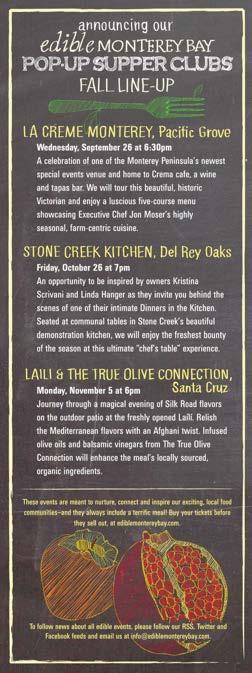
www.ediblemontereybay.com 75
Laílí
101B Cooper St., Santa Cruz • 831.423.4545
www.lailirestaurant.com

Exotic flavors of the Silk Road are served in a stylish dining room decorated in eggplant and pistachio colors and on a hidden candlelit patio. Locals rave about Laílí’s homemade naan served warm from the oven with a selection of Mediterranean dips. There is a wide variety of deliciously spiced vegetable dishes, organic whenever possible, and all meats are hormone free and free range. Open daily for lunch from 11:30am–3pm and for dinner from 5–9:30pm.
La Posta 538 Seabright Ave. • 831.457.2782
www.lapostarestaurant.com
A cozy neighborhood bistro not far from the Santa Cruz yacht harbor, La Posta Chef Katherine Stern prepares northern Italian cuisine using local ingredients—some foraged and some grown on nearby organic farms. Charcuterie is house-cured and the rest of the menu reflects whatever produce is freshest right now. Visit the chickens in the restaurant’s backyard and enjoy the eclectic atmosphere. Open Tu-Th 5-9pm, F-Sa 5-9:30pm, Su 5-8pm, closed M.
Le Cigare Volant 328 Ingalls St. • 831.425.6771 • www.lecigarevolant.com Chef Ryan Shelton serves some of the region’s most innovative cuisine in a warm dining room, with a wood-fired pizza oven in full view and a bar made from barrel slats. Taking full advantage of sustainably grown, organic local produce, meats and cheeses, the menu changes with the seasons. Small plates like smoked fingerling potatoes, flat bread pizza and pork shoulder steamed buns are always available in the wine tasting room. Open for lunch daily 12–6pm, tastings daily 12–5 and dinner W–Su 5:30-9pm. Roswell hour: 51% off glasses of Bonny Doon wine Su–F 3–6pm.

New Leaf Community Market 1134 Pacific Avenue • 831.425.1793 • www.newleaf.com See description under Boulder Creek. Open 9am–9pm every day.
New Leaf Community Market 1101 Fair Avenue • 831.426.1306 • www.newleaf.com See description under Boulder Creek. Open 8am–10pm every day.
The Penny Ice Creamery 913 Cedar Street • 831.204.2523 www.thepennyicecreamery.com Lines out the front door of its converted Spanish bungalow are evidence of Penny’s popularity. All ice cream, including bases, is made from scratch on the premises using local organic ingredients when possible. Flavors change seasonally, but two favorites are bourbon bacon chocolate and strawberry pink peppercorn. Open Su–W noon–9pm, Th–Sa noon–11pm.
The Picnic Basket 125 Beach Street • 831.427.9946
www.facebook.com/thepicnicbasketsc



Across the street from the main beach, owners of the Penny Ice Creamery have opened an alternative to boardwalk fast food. Sandwiches, organic salads, coffee and beer, all from local food artisans, and of course Penny’s popular ice cream are all on offer to eat in or eat outside with your feet in the sand. Open daily 7am-9pm.
Ristorante Avanti
1917 Mission St., Santa Cruz • 831.427.0135 www.ristoranteavanti.com


This popular, Mediterranean-style bistro recently moved into a lush, more upscale location with a larger bar and expanded seating to better accommodate its loyal fans. Avanti’s menu remains true to its long-time commitment to supporting local organic farms as well as local ranchers, foragers and fishermen. The menu changes with the seasons and specials are offered every day using local organic produce and meats, wholesome oils and imported Italian cheeses. Open for lunch M–F 11:30am–2pm, for dinner Su–Th 5–9pm, F–Sa 5–9:30pm.
River Café

415 River Street, Suite K • 831.420.1280 www.rivercafesantacruz.com
A popular spot for breakfast and lunch at the Old Sash Mill, the River Café now serves dinner on Thursday and Friday nights. All meals are made with seasonal, local and organic ingredients, prepared with a Mediterranean flair. Homemade granola and quality panini. Dine inside or on their redwood deck. Open M-Sa 6:30am-6pm, Su brunch 10am4pm. Organic produce and flower stall open Tu 11:30am4pm.
Soif Restaurant and Wine Bar 105 Walnut Ave. • 831.423.2020 • www.soifwine.com This wine-centric downtown restaurant is housed in a hip, loft-style building and includes a wine shop next door. Food reflects Chef Santos Majano’s love for Mediterranean flavors, and each dish is paired with a wine suggestion from the vast wine list. Monday evenings there is a raw oyster bar with live jazz. Tuesday is tapas night. Restaurant and wine bar open Su-Th 5-9pm, F-Sa 5-10pm.
Vivas Organic Mexican Restaurant

1201 Soquel Avenue • 831.425.8482 www.vivasorganic.com
A splashing fountain suggests an old Mexican patio but the food is a modern, organic and delicious take on south-ofthe-border classics like tacos, tostadas, quesadillas and burritos. All meats and vegetables are organic. Local juices, organic white and brown rice are available, as well as vegan options. Open M–F 10am–10pm, Sa–Su 9am–10pm.
Whole Foods Market
911 Soquel Avenue • 831.426.9901 www.wholefoodsmarket.com

See Whole foods description under Capitola.
WATSONVILLE
Gizdich Ranch
55 Peckham Rd. • 831.722.1056 www.gizdich-ranch.com
Visitors from great distances love this third-generation, family-run farm business that popularized the “pik-yor-self” experience just east of Watsonville’s Interlaken neighborhood. Tour the farm, pick fresh apples or berries or watch the action inside the juice-pressing barn. No one leaves hungry if they spend time at the bakery-deli that pleases with its fresh pies, shortcakes and pastries, along with hearty sandwiches and box lunches. This family friendly experience is also a treat for kids, who will enjoy the wide-open spaces and the homemade popsicles and slushes. Open daily, 8am–5pm.
76 edible monterey bayfall 2012
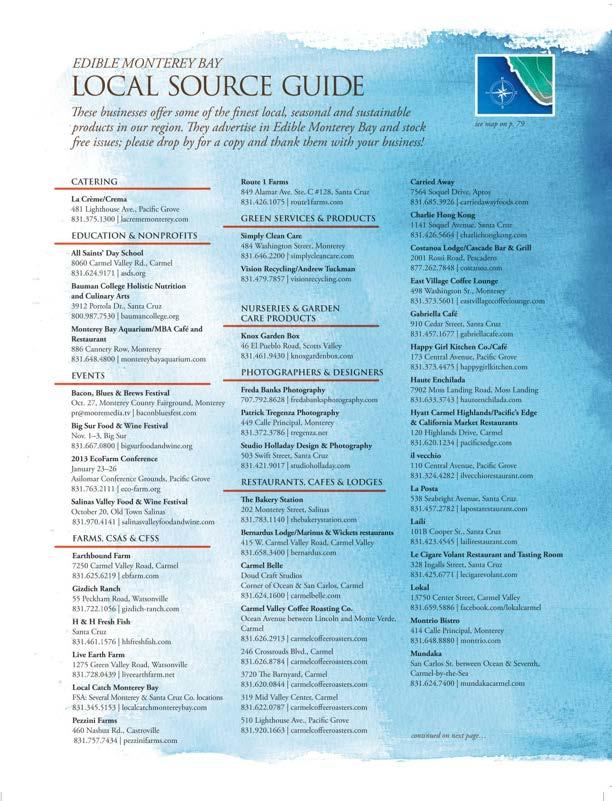
www.ediblemontereybay.com 77
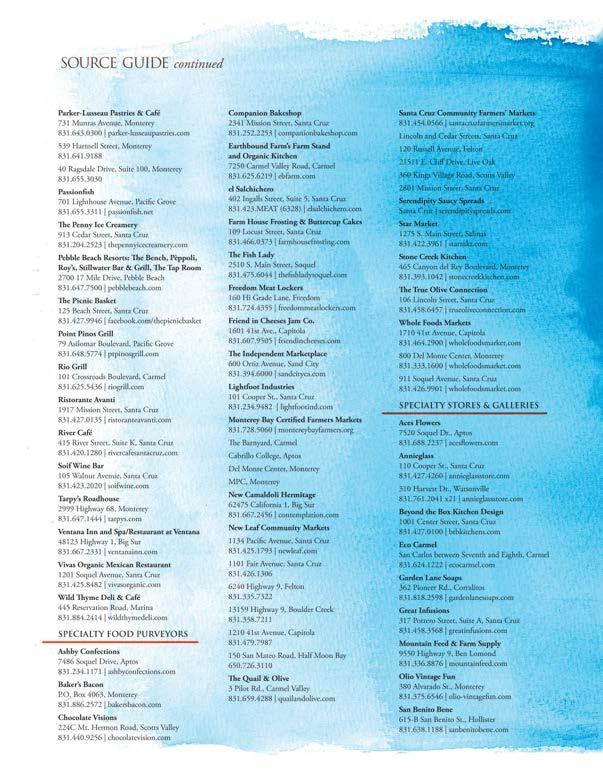
78 edible monterey bayfall 2012
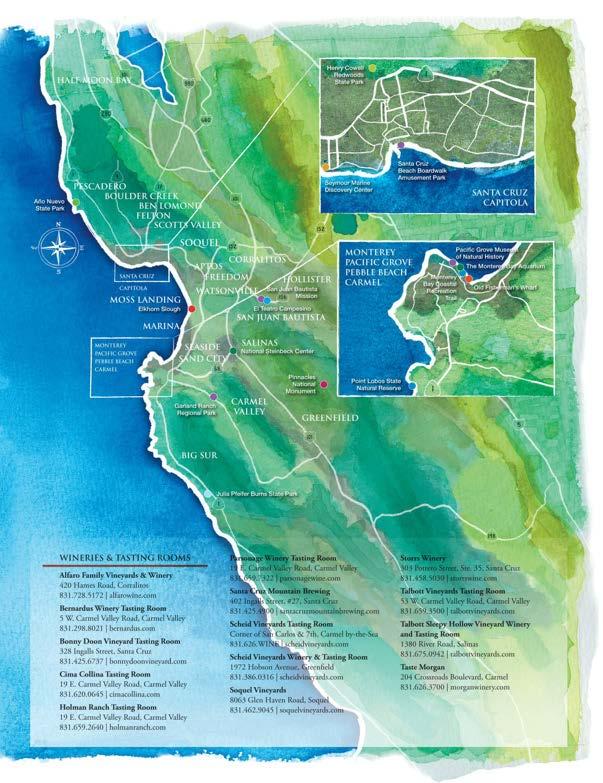
www.ediblemontereybay.com 79
Local Libations
3 of a Kind
Soft drinks reimagined by a mom
By Ray Patterson
stands along the roadsides with transparent vessels of exotic fruit drinks, effective thirst quenchers during the hot months.
So Appel began experimenting with different flavor combinations, starting with apple juice and limeade, calling the drink Appelade after her family name. Then she grew more creative, using ginger root, cloves, fresh berries, basil and natural sweeteners such as honey or maple syrup. The next step was carbonation, and she purchased a Soda Siphon, a modern-day seltzer bottle that dispenses bubbly beverages.
3 of a Kind was born.
After much experimentation on her kids, her neighbors and the UPS guy, Appel narrowed down her flavor profiles, secured a commercial kitchen (thanks to her friends at Siamese Bay Restaurant in Monterey) and purchased soda kegs to store her carbonated creations.
You can find her at the Tuesday farmers’ market on Alvarado Street in Old Monterey, and at the Independent Marketplace the first Thursday of each month ($4 for a 12-ounce serving over ice, or buy a refillable bottle for $5 and take the drink home).

“I know Kate doesn’t like to use the word soda, but it’s great to see craft soda making a comeback,” says Todd Champagne, manager of the Independent. “She has created a healthy carbonated beverage, and her flavors have been really inventive. People have responded well to her product.”
Her most popular drinks? Strawberry and basil is a huge hit, and lemon-lime and cilantro went fast (especially at home with her husband’s adult version that included tequila).
“I’m so happy people like what I’m doing,” says Appel, “because I’m having so much fun doing it.”
Appel’s methods are a closely guarded secret, but she says that making your own carbonated fruit drinks at home is easy, even without the expensive equipment. Just use fresh fruit, bottled sparkling water and a lot of imagination. She’s shared a simple recipe below.
Ray Patterson is a freelance writer based in Monterey.
All around the Monterey Bay area, consumers are gradually getting wise to the $74.2 billion commercial soda industry and its unwholesome lists of ingredients, like high-fructose corn syrup, caffeine, phosphoric acid, sodium citrate, potassium benzoate and glycerin. But are there more healthy sodas out there?
Kate Appel uses organic fruits, herbs and natural sweeteners— and refuses to call her product soda. Last year, the Pacific Grove mother of triplets (all boys, age 7) started her own “sparkling fruit drink” company called 3 of a Kind, a nod to her sons and to her simple list of three ingredients.
“I didn’t want to associate my product with soda,” she says. “What I’m doing is something so different.”
It all started after she tried (and ultimately failed) to keep her sons away from the unhealthful duopoly of Coca-Cola and Pepsi. But one day they came home from a birthday party hopped up on soda and cake, and she headed to her kitchen to create something better.
Appel came to this country from Thailand in 1996 to study computer graphics (eventually marrying Tim Appel, at the time a student at the Defense Language Institute). All throughout her native land are small
Strawberry-Basil Sparkling Fruit Drink (Aka Soda)
2 cups water
1 cup sugar
2 cups (12 ounces) fresh, organic strawberries ½ cup fresh herbs, such as basil ¼ cup fresh lemon juice 1 cup bottled sparkling water Ice
In a small saucepan, bring the water and sugar to a boil over medium-high heat, stirring constantly, until the sugar has dissolved, 2 to 3 minutes. Add basil leaves and set aside to steep and cool for 20 minutes. Remove basil. In a blender, combine the cooled syrup, strawberries and lemon juice. Blend until smooth. Add the sparkling water and pour into an ice-filled pitcher.
80 edible monterey bayfall 2012
Photo by Geneva Liimatta














 By Lisa Crawford Watson
By Lisa Crawford Watson















 by Alan Lovewell
by Alan Lovewell
















 By Deborah Luhrman Photography by Ted Holladay
By Deborah Luhrman Photography by Ted Holladay































 Courtesy AQUA TERRA Culinary in Pacific Grove
Courtesy AQUA TERRA Culinary in Pacific Grove


 By John Cox
By John Cox



























































































